KAPITEL VII
"STEINZEITLICHE BILDSCHRIFTZEICHEN" IN ALPHABETISCHER AUFLISTUNG. ÜBERWIEGEND FEUERSTEIN-SKULPTUREN, JEDOCH ZUM VERGLEICH SIND AUCH ANDERE MATERIALIEN HERANGEZOGEN WORDEN, UM EINE STANDARDISIERUNG DER BILDZEICHEN ALS VORLÄUFER DER SCHRIFT UND SPRACHE ZU BELEGEN. WAR ES AUCH EINGESETZT WIE "LERNPROGRAMME" ÜBER DIE FAUNA ? WENN NICHT ANDERS ANGEGEBEN, STAMMEN ALLE FUNDE AUS DEM NORDDEUTSCHEN KIESGRUBENAUFSCHLUSS VON GROSS-PAMPAU, SCHLESWIG - HOLSTEIN.
E = ELEFANT F=FISCHE FLUSSPFERDE bis FUßFORMEN
INTRODUCING IN ALPHABETICAL ORDER PICTURE SIGNS FROM THE STONE AGE; MAINLY STYLED IN FLINT MATERIAL BUT COMPARED TO IDENTICAL SHAPES IN DIFFERENT ROCK TYPES; A POSSIBLE "TEACHING AID" about THE LOCAL FAUNA? IF NOT STATED OTHERWISE, ALL FINDS ARE SAMPLED FROM THE GRAVEL PIT OF NORTHERN GERMANY; GROSS-PAMPAU.
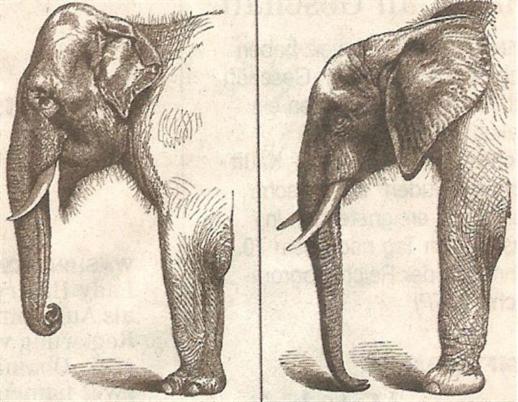
LINKS: ASIATISCHE ELEPHANTEN MAXIMUS OF 3.5 Metern/ RECHSTS:LOXODONTA africana Größe 4 Meter.
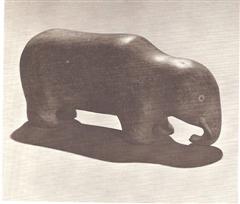
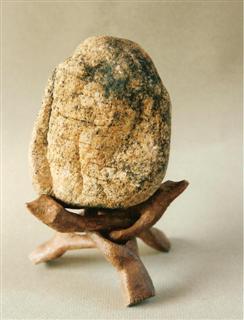
Moderne Gestaltung der Inunnit/ Kanada Moschusochse mit Elefantenkopf in Speckstein vom Baker Lake. Rechtes Bild: Elefantenkopf mit Rüssel und Ritzungen/The art of the Canadian Eskimo, left and an elephants head with trunk and paralles carvings, to the right, material: quartzite
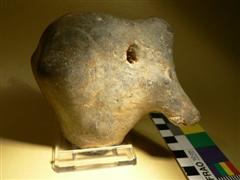
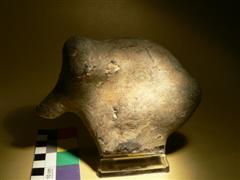
Vorder- und Rückseitenansicht einer natürlichen Flintsteinknolle mit unausgewogener Standfläche und Loch. So oder ähnlich, könnte die Ausgansbasis für das folgende Stück ausgesehen haben, siehe nachstehendes Foto einer " Rüsseltiedarstellung".
Back and frontview of a flint nodule with an inadequat plattform to stand on.. There is also a hole in the flint material leaving open, if it is an artificial one, but in general, it is a very good "demonstrator" for the following larger object in flint suggesting that a natural nodule is needed to shape a wanted sculpture.
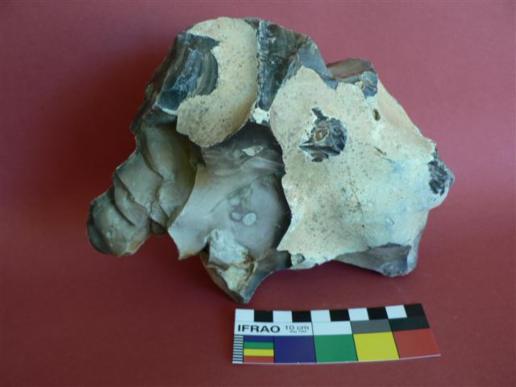
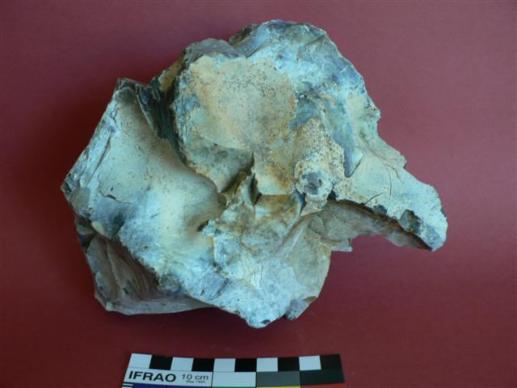
Vorder- und Rückseitenansicht einer bearbeiteten Knolle im Vergleich. Die Rückseite hat längere Zeit an der Oberfläche gelegen und zeigt im Kontrast zu der Unterseite sehr viele blau-weiße Patina, wie sie an diesen Steinen oft auffällig wird, wenn sie nicht vollständig geschützt liegen. Hier ist der Rüssel sehr gut dargestellt und auch die Ohren, sogar der Stoßzahn ist angedeutet.
Back and frontview of one object, with different colouring on each side. The object must have rested for a longer period of time uncovered by sedimentation. This made a patination "GROWING" OVER THE TIME INVOLVED. Showing the large ear, the trunk is well styled and even the "tusk" is indicated, see front view.
Unterschiedliche Materialien: Sandstein, Flint und quarzitischer Sandstein./ sandstone, flint and quartzite material
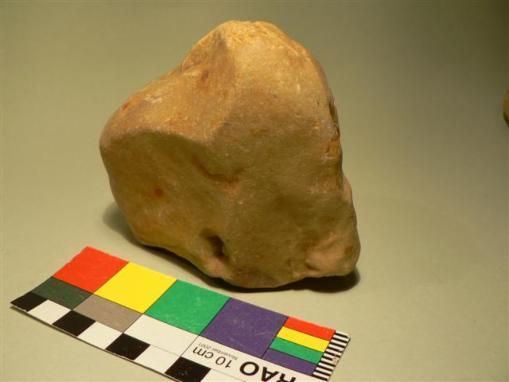
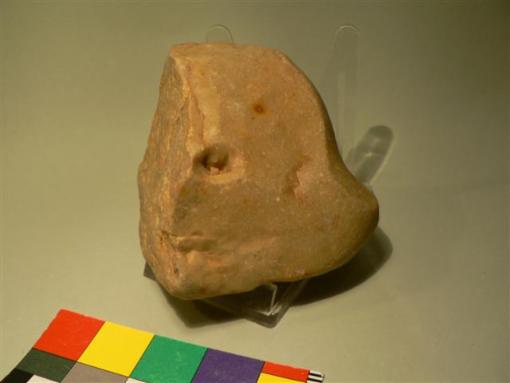
Ein quarzitischer Sandstein mit Standfläche versehen, zeigt seine Elefantenform mit Rüssel und sehr verschliffenen Konturen ( Wind- o. Wasserschliff). Eine Vertiefung im Stein soll ein Gesicht mit Auge und Mund darstellen.
Quartzit sand stone shaped in the form of an Elephant, wind and water gave the object a very old appearance. A cupule is used to create facial impressions.
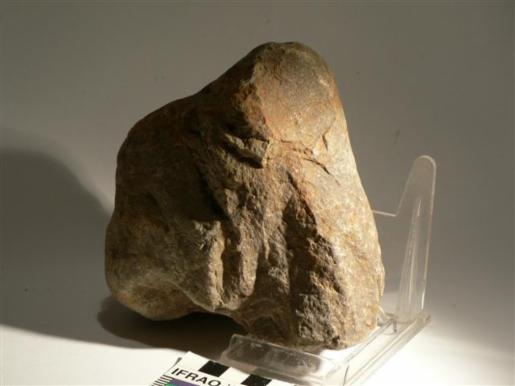
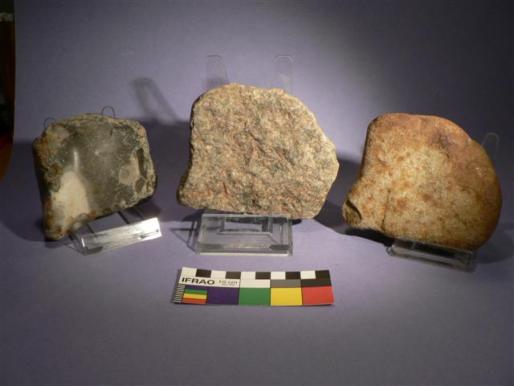
Elefanten links, Feuerstein, mittig Granit, rechts Sandstein./Flint, granit, Sandstone elephants.
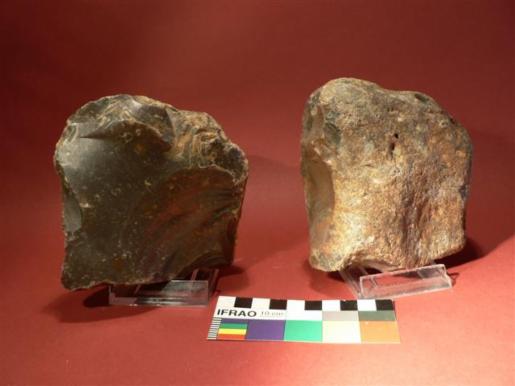
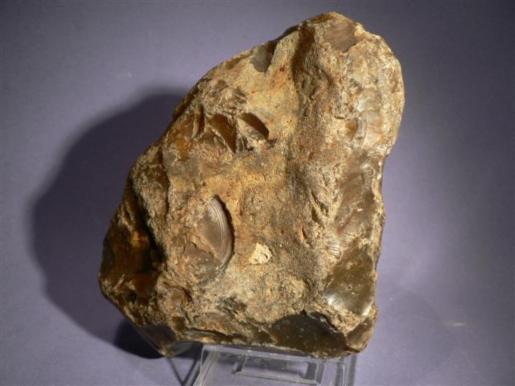
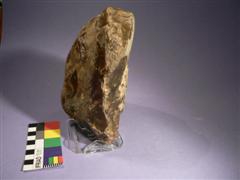
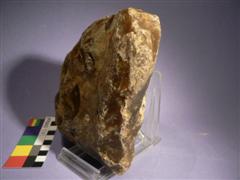
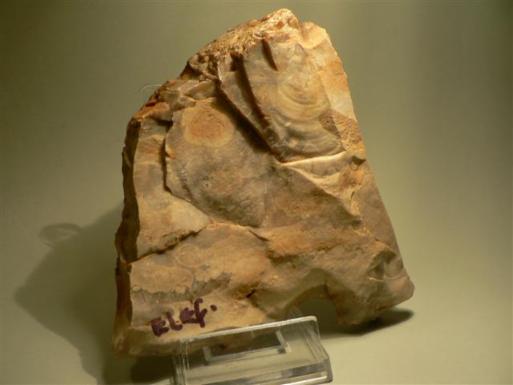
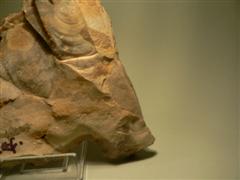
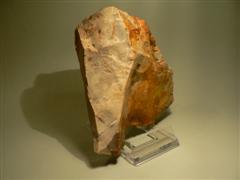
Ein Elefantenart, wie er auch in Granitgestein gefertigt worden ist, hier nun die Vorder, Rück,- u. Seitenansicht. Dieser Typ ist polymorph und trägt auf seiner Flügelschwinge ein Löwe/Menschgesicht siehe Foto unten.
This typ of Elephant is also fashioned in granit rock. Here his front, back- and side view in Flintstone, offering on the back impression a combination of human and lions head on a wing with colour traces.
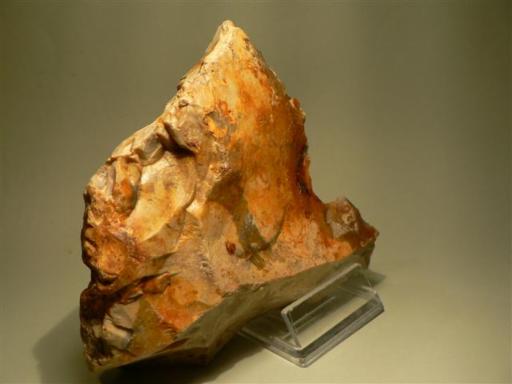
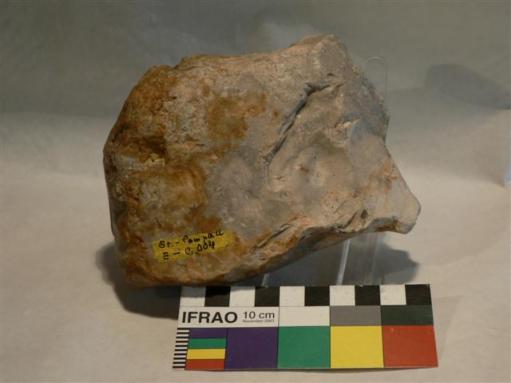
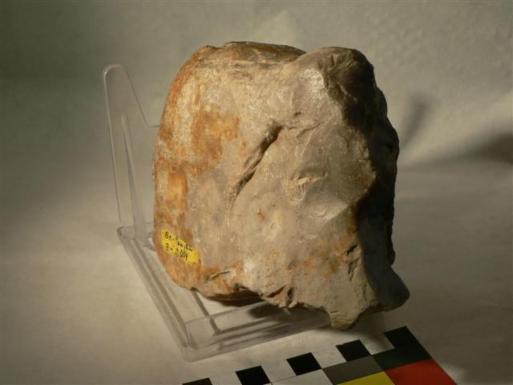
Waldelefant? Man beachte einen zweigeteilten Rüssel, ein leicht angedeutes Auge mit einer auf gleicher Höhe zu erkennenden Kopfdarstellung eines Rüsseltieres.
Perhaps a forest elephant. Please compare the different type of "trunk" and the miniatur picture of an elephants head impression, to be noticed near the "chipping" of the eye.
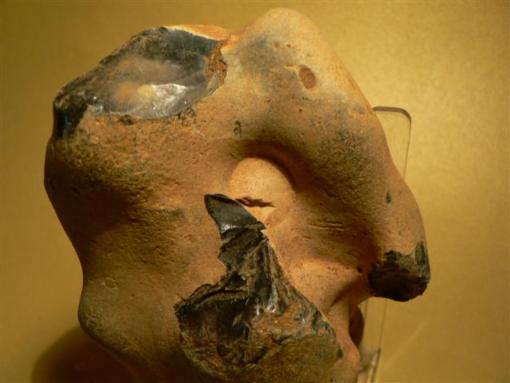
Bilderschriftzeichen "E"u."F": Symoblzeichen "E" für Elefant (Hauptmerkmal = Rüssel) darunter Flügel einer Fledermaus, hier in alphabetischer Reihenfolge. Siehe dazu auch Kapitel IX mit der Buchstaben Reihenfolge "H" und "G", für HASE u. GANS Ob hier nur noch der "Zufall" zu Werke ging, ist offen. HASEN-TYPEN AUF KAPITEL IX.
Similar to the pictograms found on rocks, is this "picture sign" created from a flint nodule. Presented is the trunk of an elephant, natural formation on the nodule, but with working marks at the end of the trunk. The eye is "sitting" in a correct position for the species. Symbolizing the letter "E" for elephant and below the "wings of a bat" are indicated, in German language letter "F"=for Fledermaus. E and F letters here in perfect alphabetical order. This phenomen occures again with the letters H and G, presented on chapter IX, when hares and goos are sings on flint.
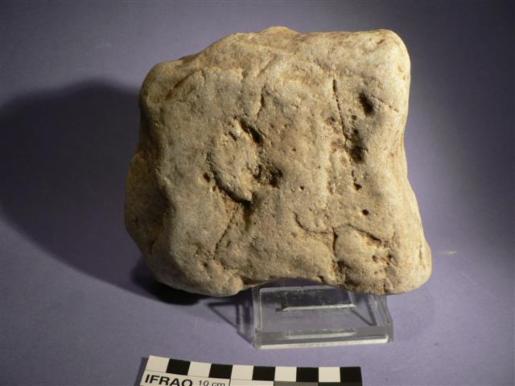
Flankiert von Elefantenkopfteilen ist hier in der Mitte dieses Steines eine Figur zu erkennen, welche ein Musikinstrument spielt (Flöte). Durch die Anordnung von gleichgroßen Löchern enden diese im Profilgesicht der Figur unterhalb des Nasenvorsprunges . Allerdings weitet sich das Instrument am unteren Ende in eine Gesichtsmaske mit "Totenkopf-Impressionen"? Über die Funde von Hohle Fels in Süddeutschland, mit der Entdeckung einer kompletten Flöte, wird nun diesem Objekt" eine indirekte Datierung von wenigstens 35.000 Jahre oder älter zugewiesen.
Flanked by 2 elephant heads on both ends of the sculpture, a figure is shown in the centre of this stone, seemingly playing a "musical instrument. In a straight line a number of exact holes can be noticed, ending below the nose . Small at the mouth part, this type of "flute" is enlarging and ending in a carved "head", death mask like. The now discovered "flute" in southern Germany is older than 35.000 years. For the first time these cultural objects have an indirect dating.
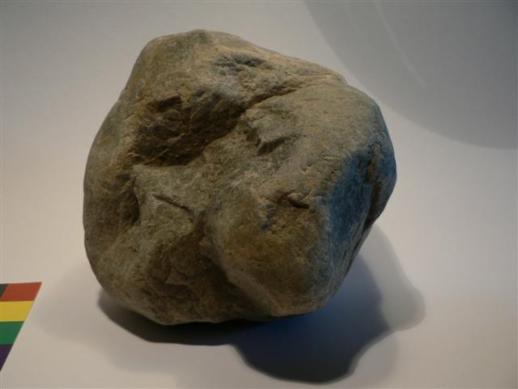
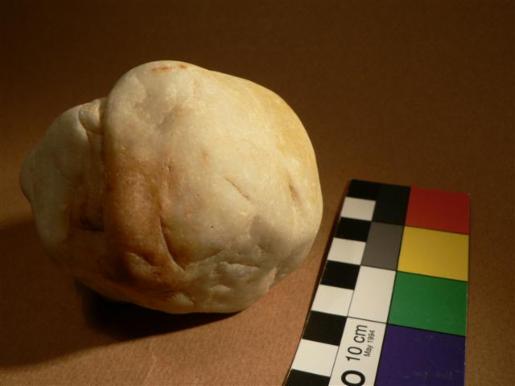
Quarzitischer Stein mit Elefantensymbolic, 2 Fotos von einem Stein, Vorder-und Rückseitenansicht oben und unteres Bild. Maskenartige Gesichtsandeutung auch hier. Weitere interessante Elemente dieses kleinen Steines werden unter Teil II der Miniaturen gezeigt.
Elefant symbolic, here on one stone in 2 Silhouetten shown, see also photo below presenting back and front view. A large facial mask in the centre of the large body is separating at the same time the legs. More interesting elements found on this small stone, will be shown under Part II of the miniatures.
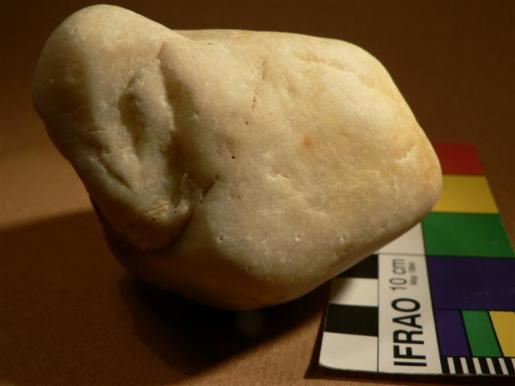
Rückseitenansicht, mit gestalterischen Kerben, die nochmals markante Einzelheiten eines Elefantenkopfes heraustellt.
Backside view with carvings, accentuating the elements of an elephants head.
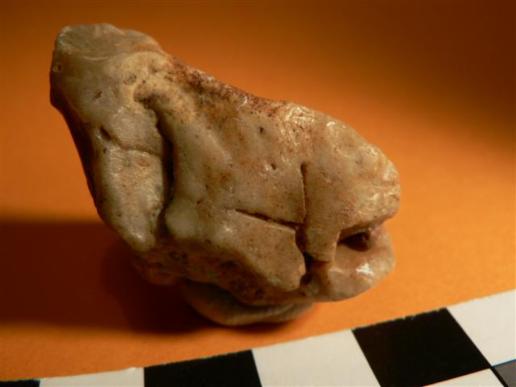
"Eingangsbild" von Kapitel III, MINIATUREN : Ein Vergleich mit der Bilderserie des quarzitisch, gelben Steines, zeigt die Umrisslinienführung in Wiederholungssilhouette. Am Elefantenkopfteil sind an Stelle des Ohres, hier nun ein" aufgehender Vollmond" mit einer davorliegenden "Seekuh" zu erkennen, die "Weiblichkeit" dieser Tiergattung ist am Unterleib des Tieres, durch ein bekanntes Kürzel, sichtbar gemacht. Eine weitere Maske(Foto unten) mit breiter Nase befindet sich auch hier am unteren Teil des Steines. DAMIT IST EINE THEMENWIEDERHOLUNG BELEGT.
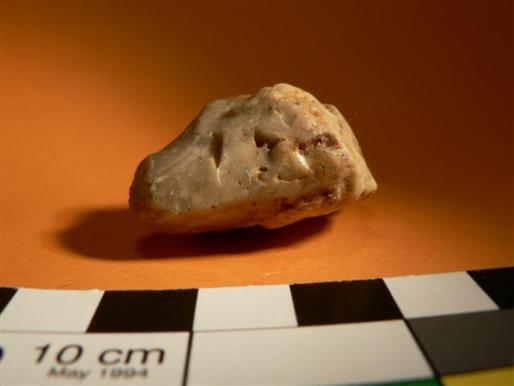
Engl. text from above. A portable art object. This 3cm large filint stone has many features similar to the yellow quartzite implement, introduced in a series of pictures above. The outline of an elephants head is almost identical, except, that the part of the ear shows now a "full moon," partly covered by a large body of a "sea-cow ". On the back side a "mask" appears, with a large nose, very similar to the mask on the quartzite object. This repeated pattern of motifs stands again for standardized pictures and copying processes.
Weitere Darstellungsweisen von Elefantenformen
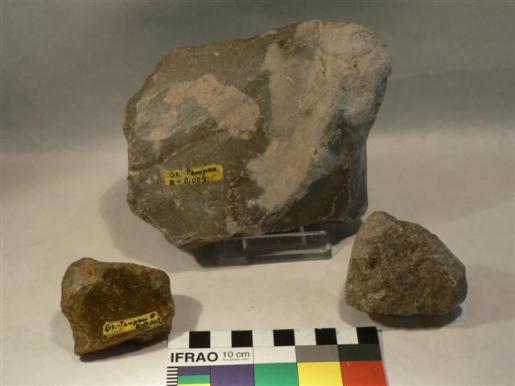
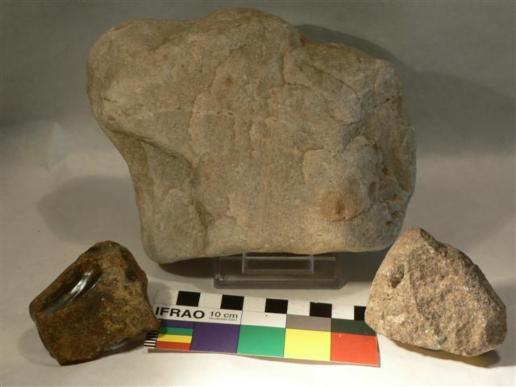
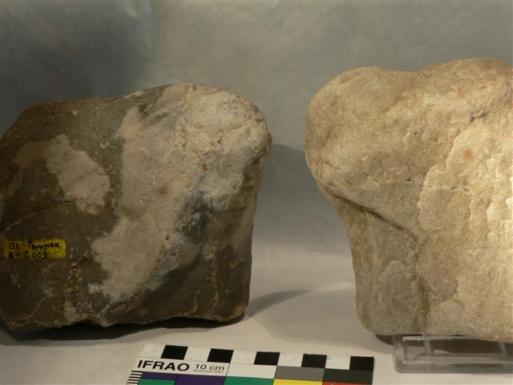
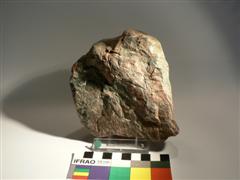
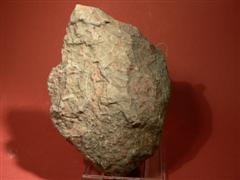
Identisches Gestein, aber unterschiedliche Bildaussagen. Links ist die typische Silhouette eines Elefanten, rechts erscheint eine Werkzeugform, hier als Blattform gedeuted, denn einer kleiner Affenkopf krönt die Spitze des Objektes, und macht das Stück damit zu einer Schriftbildaussage.
2 identical rock material with different "picture" messages. While to the left we see again the corpus of an elephant in silhouette, the right implement has a smaller "handaxe" or leaf form with the image of an ape head on top.
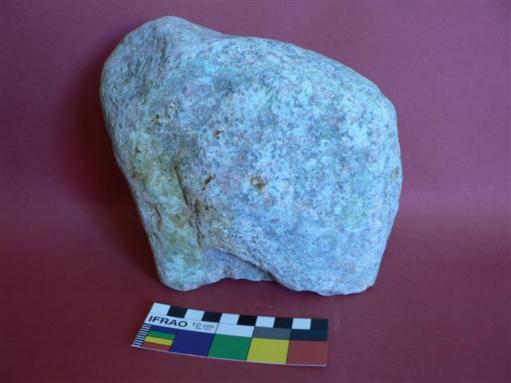
Granit-Elefant.
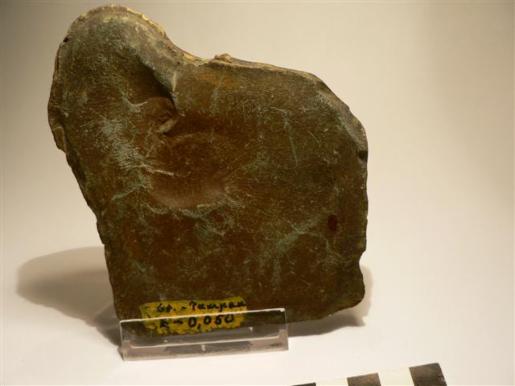
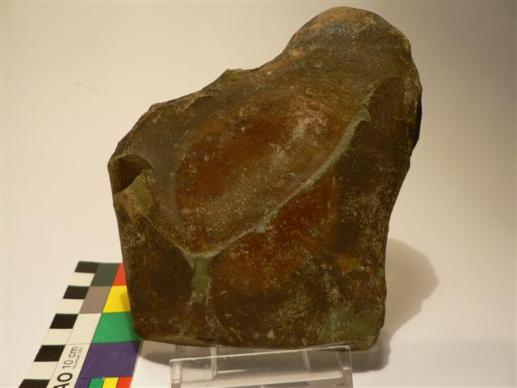
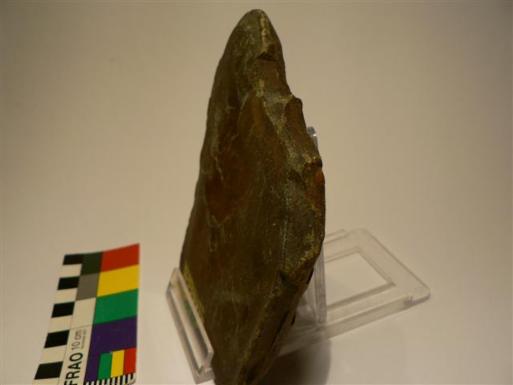
UMRISSFORM eines Elefanten in 1,00 -1,5cm Stärke, aus Tonsandstein. Das Stück wirkt abstrakt, hat auf einer Seite eine schwach angedeute einseitige "Maske" wie eine Kürzelschrift, siehe nächstes Foto.
Silhouette: shape of an elephant in clay or sediment stone, abstract version. Width of 1,00cm to 1,5 cm. A one eye "mask" is presented when the object is placed up side down, see following photo impression.
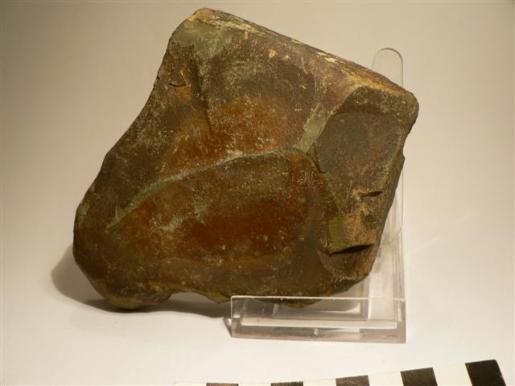
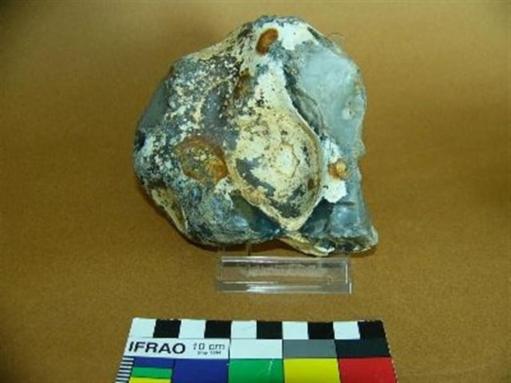
Flintelefant mit Kopf- und Rüssel gewendet./ Elephant with slightly turned head and trunk fashioned in flint.
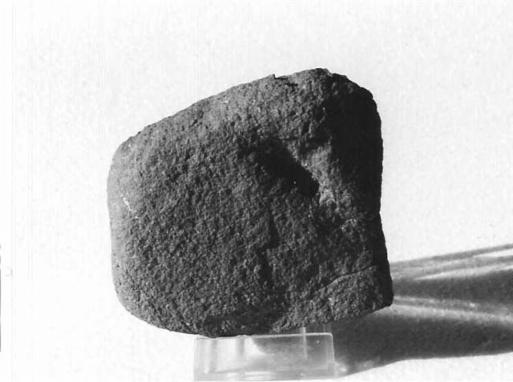
Vulkanisches Gestein in bekannter Elefanten - Darstellung von LANZAROTE, Spn.
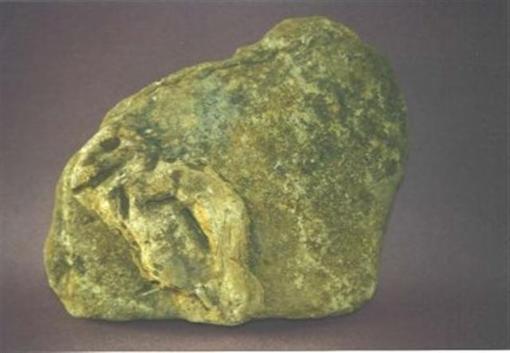
Umrissgestalt eines Elefanten aus Lehm. Aufliegend ist ein Fossil einer Vogelart in quarzit.
Outline of an elephant in clay featuring a type of "bird fossil"
Eulen aus Flintgestein mit extra Images
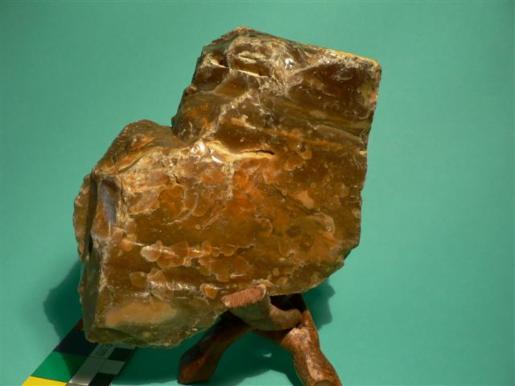
Eine Feuerstein-"Eulen-Glyphe" mit durchscheinenden Pferdedarstellungen. Ein Pferdekopf mit Mähne und nachgearbeiteter Rückenlinie zeigt eine Seitenansicht eines Pferdekörperumrisses zusammen mit einer weiteren Pferdekopfandeutung gegenüberliegend. (vgl.dazu nächstes Foto) In Norddeutschland findet man noch heute diese Form der "gekreuzten Pferdeköpfe", als Holz-Symbol auf vielen Hausdächern. Die Eule selbst hat ein geöffnetes und ein geschlossenes Auge und hat die für sie typische, entschlüsselte Grundform innerhalb des Inventares.
This flint owls typical shape, carries also 2 horse-heads crossed, the one to the left seems a smaller size. The 2 horse heads styled as a cross, is a "symbol" still found as a" wood-carving" on the roof tops of many houses in northern Germany. See photo below.
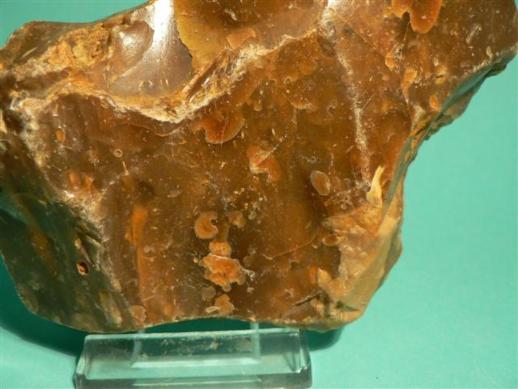
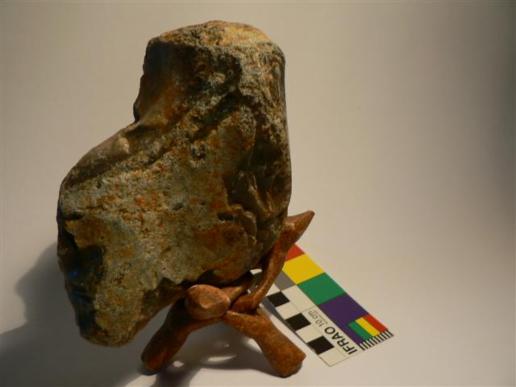
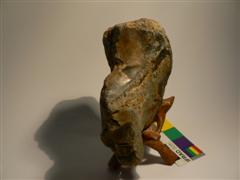
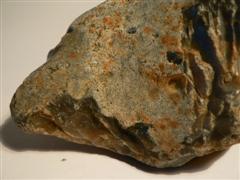
Das Erscheinungsbild dieser E U L E aus Flintstein wirkte wenig überzeugend beim seinem Ergreifen, wurde jedoch über seine Flügelstellung zu anderen Skulpturen dieser Typenserie zugeordnet.
Not a convincing impression made this O W L in flint when sampled, but was "secured" by finds in different stone material, with identical shapes and traces of workmanship. (see above owl.)
FEUERSTEINABSCHLAG/FLINT-FLAKE
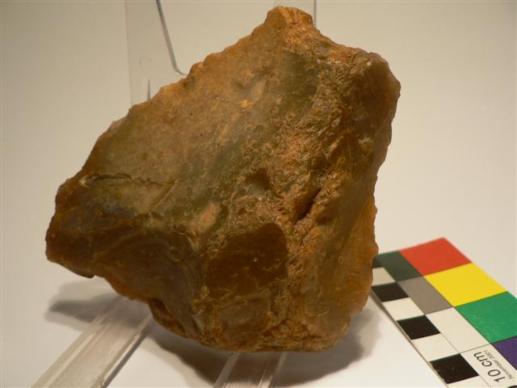
Eule oder Kauz/ owl
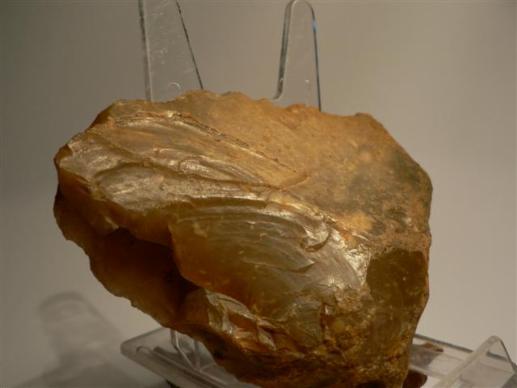
Auch dieser dünne Abschlag aus Feuerstein ist nur von der Vorderseite "lesbar", siehe vorangestelltes Foto. Erneut halfen die Merkmale über Federn oder Flügel die Art der Zuordnung zu der Eulen-Typologie. Diese 2 Ansichten sollen erweitert sein, siehe nächstes Foto mit einer eigentümlichen Katenbearbeitung, die nicht den bekannten Abnutzungsspuren von Schabern oder sonstigen "Werkzeugen" entsprechen.
A very typical "tool" type of scraper becomes "readable" only from one side. The backside is smooth without any markings. It was the front part that reminded of bird feathers, and was suggesting an owl type of bird. The next photo impression gives details traditionally interpreted as use-wear markings of a scraper or other tool, but these markings are not comparable.
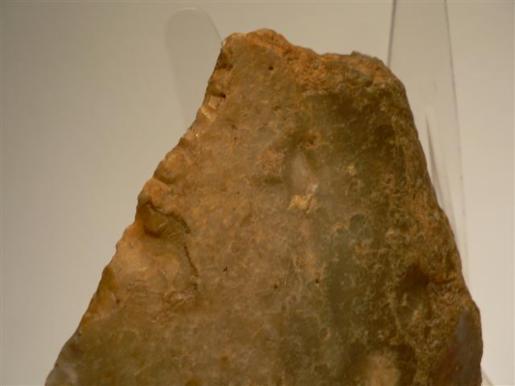
Detail Foto of traces of use-wear???/ABNUTZUNGS-SPUREN EINES "WERKZEUGES"???
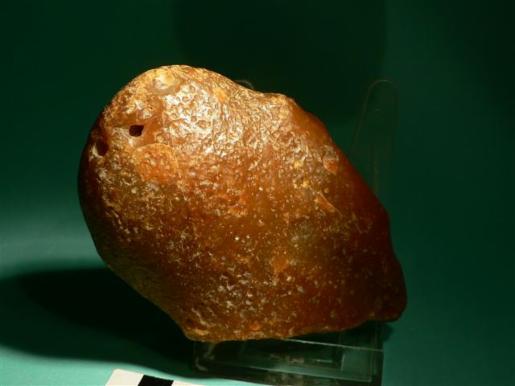
Junge Eule, das linke Auge scheint gebohrt zu sein. Untersuchungen dazu fehlen. Materialwahl unbekannt, wirkt farblich wie Bernstein. Vgl. nachstehende Abbildungen des Stückes.
Little owl, 2 eyes are depicted, but no expert verdict available. Material choice and colour gives the impression of amber, see next photo.
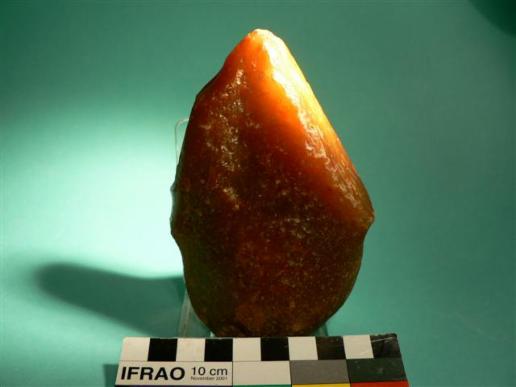
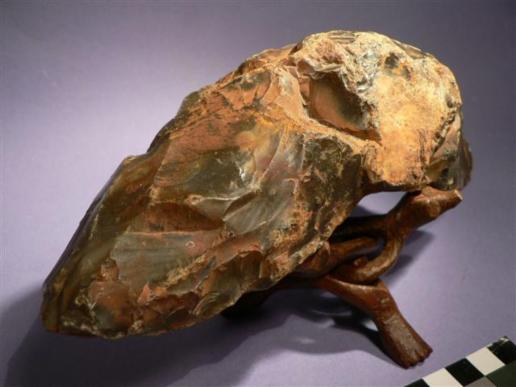
EULE IN FLINTSTEIN MIT FEDERKLEID
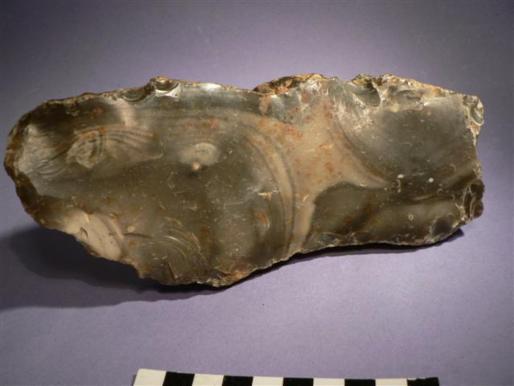
EULE UNTERSEITE; rechts aussen Spuren von Ohrenandeutung durch extra Abschlagspuren.
FISCHFORMEN einschließlich MEERESSÄUGERN
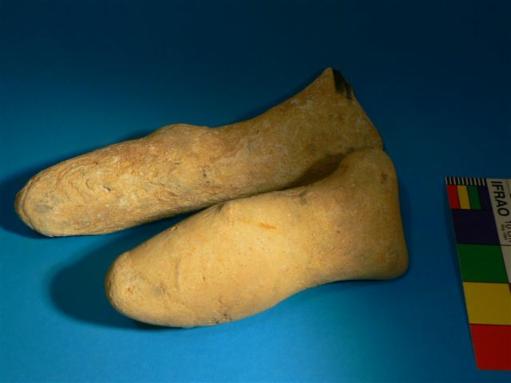
Natürliche Flintknollen als Ausgangsmaterial zur Bearbeitung/Flint-nodules, the basics for shaping
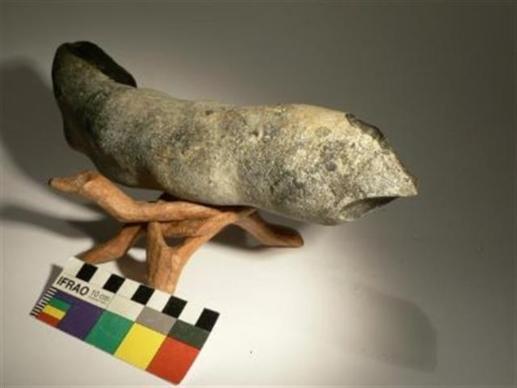
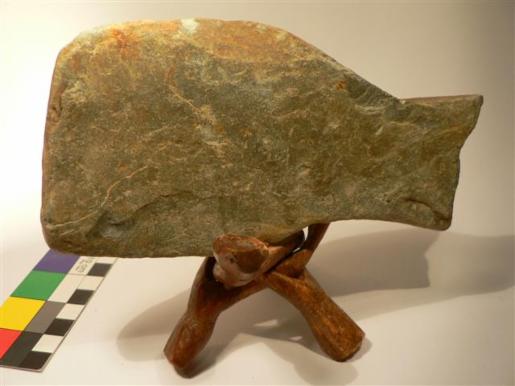
Gehärteter Lehm als Fischgestalt./ Clay-fish
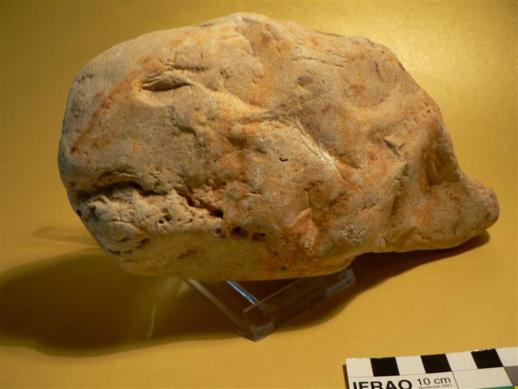

Eine polymorphe Darstellung, Großkopf-Fisch mit ausgeprägten Fangzähnen, auf der gegenüberliegende Seite der Kopf einer Krokodil- Art wie Kaiman.
Polymorph sculpture representing the fish-species and alligator.The huge head of the fish does resemble an ancient fish type?
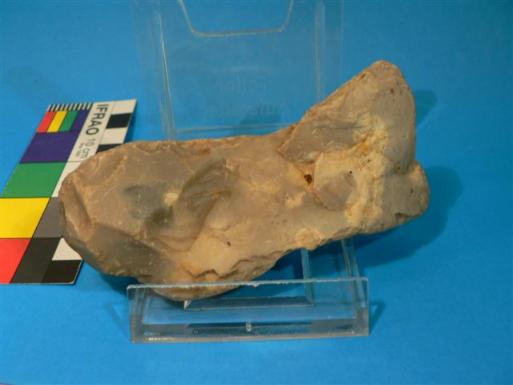
Zweiseitig bearbeiteter Feuerstein in Fischform/ bi-facially worked flint into a fish silhouette.
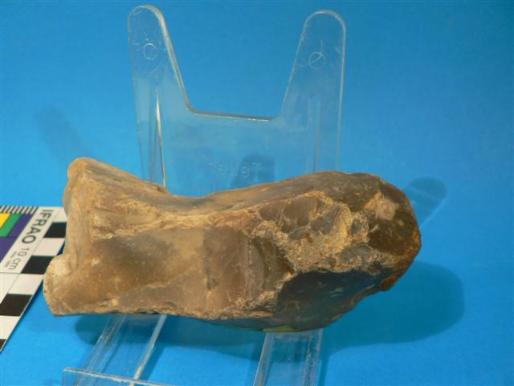
Fisch mit Gesichtsmaske unter Einbeziehung alter anhaftender Rinde oder Kortex./Cortex used for a "facial mask", on a fish sculpture.
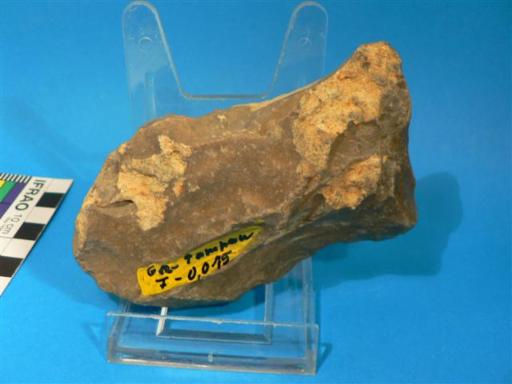
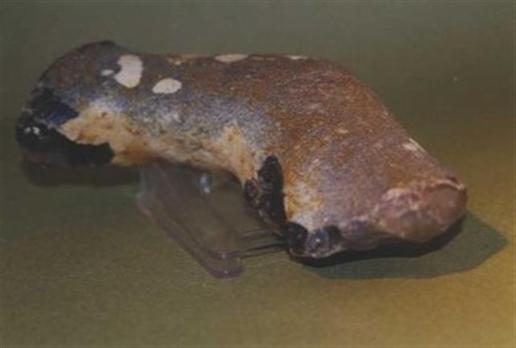
Größere Flintknolle mit unterseitigen Eingriffspuren, hier die Bewegung eines großen Meeressäugers -Wal- / Large flint object, has traces of workman ship on the bottom part of the nodule, and reminds of a large whale.
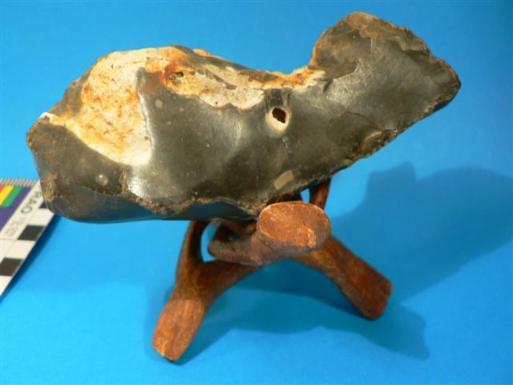
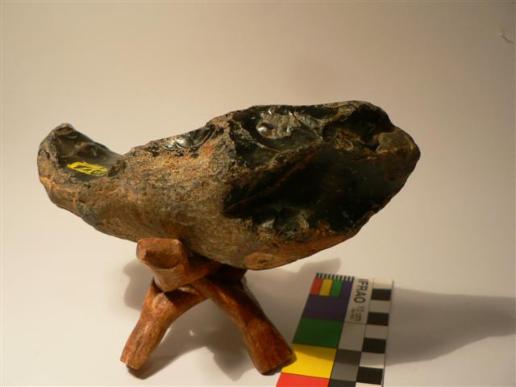
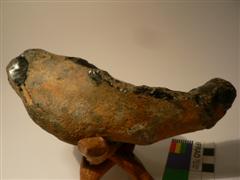
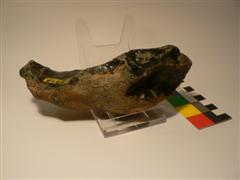
Die bereits schon erkannte "Gesichtsmasken - Impression" findet sich auch auf dieser Fischskulptur. Rückseitiger Gesamteindruck ist einer Vogeltypologie zuzuordnen und ist damit eine doppelseitige Skulpturendarstellung.
A facial mask also on this fish sculpture, turning into a double figuration, when viewed from the back side. Typologie of this inventory.
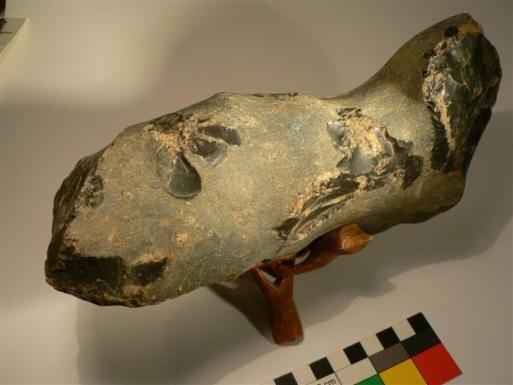
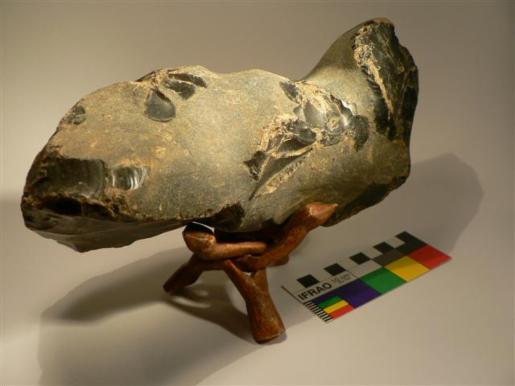
Wal-Hai/or whale-shark
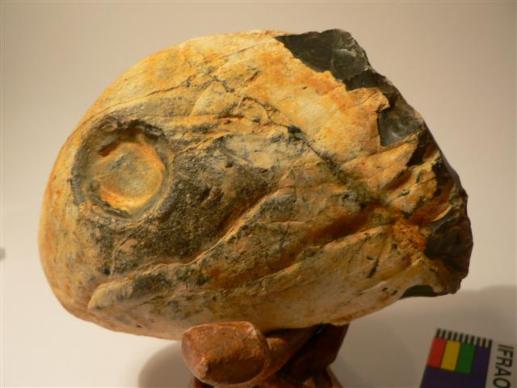
Wie bei anderen Skulpturen sind Einzelelemente von diesen Skulpturen, ob Tier oder Mensch erkennbar geworden. Auch bei Fischen sind es die Kopfteile die auffällig sind mit Merkmalen von großen und kleinen Augen, sowie anderen Hinweise, deren Interpretation soft schwierig erscheint und eine große Anzahl von Funden bei einer Vergleichsarbeit voraussetzt. Siehe dazu auch die EXPERTISEN-VERLINKUNG dieser Webseite mit den Untersuchungen eines Fischkopfes und einer Fischform aus dem Sammlungsbestand. Arsen Faradj. klick Expertise-Link
The inventory shows in general single elements of certain sculptures of humans and animals. The fish sculptures make no exception here and single head sculptures are common. See for this the EXPERTISE- LINK of Arsen Faradj. on this website. Large or small eye depictions can be noticed together with additional carvings not always easy to be interpretated, unless a large amount of identical sampled material is available.
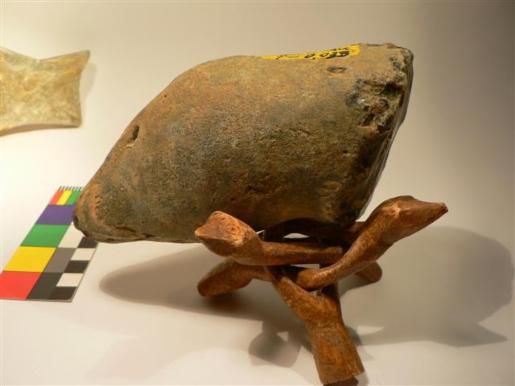
Fischköpfe aus Flint.
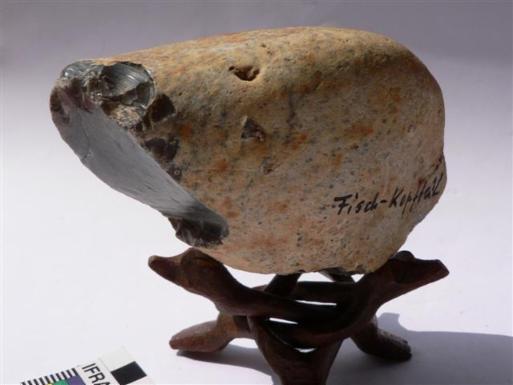
Man beachte die Gestaltung der Maulpartie an diesem Flintstück und vergleiche sie mit anderen, unterschiedlicher Gesteinsarten wie Granitgestein aus Gr.-Pampau und Vulkangestein aus LANZAROTE, Spn.
The working traces to shape the fish mouth is also evident on full size fish sculptures and on several other materials, like granit from Gr.-Pampau site and volcanic stone from the Island of LANZAROTE.
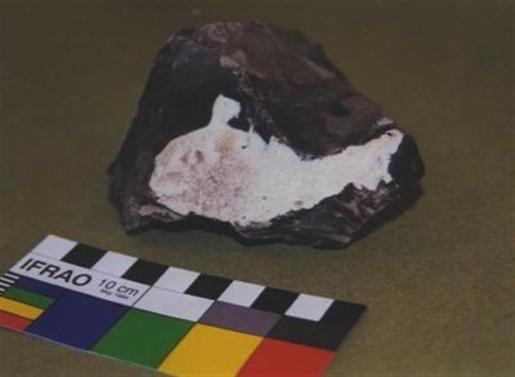
Schwarz auf Weiß. A white cortex is used to shape the whale on black flint.
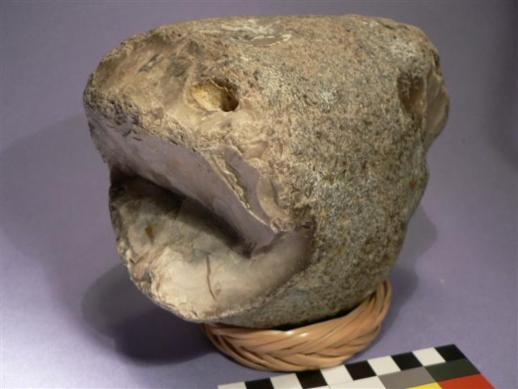
Fischkopf mit aufgerissenem Maul. Wide open mouth styled on a fish head.
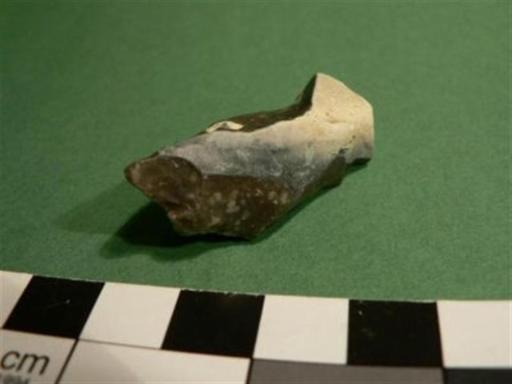
Microlithic shape of a whale shark species, which was found in fossil bones in the miocene clay (11-14mill years old) of a 3 m large shark at the Gr.-Pampau site, the first shark found in Europe. Also several whales were discovered at the same site. Read also www.shafftwissen.de under chapter I and bio-stratigraphic discoveries, including parts of a dolphine. Translation below:
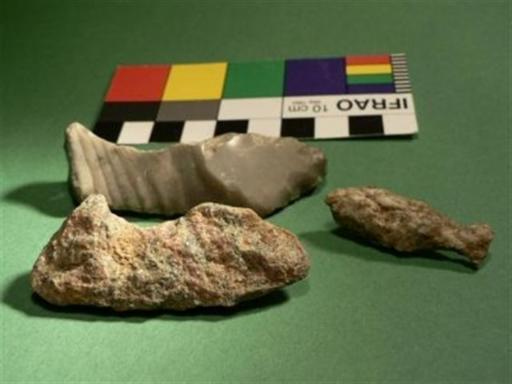
Miniatur Gestaltung von Fischformen und Meeressäugern. Mehrere Walskelette wurden aus dem Miozänen Ton (11-14 Mill. Jahre alt) dieser Grube, geborgen, ebenso wie das Skelett eines 3m langen Hai, damals der einzige Hai-Fund in Europa. Für mehr Information siehe www.schafftwissen.de auf Kapitel I, " bio-stratigrafische Erfassungen" unter denen sich auch Teile eines Delphines befanden.
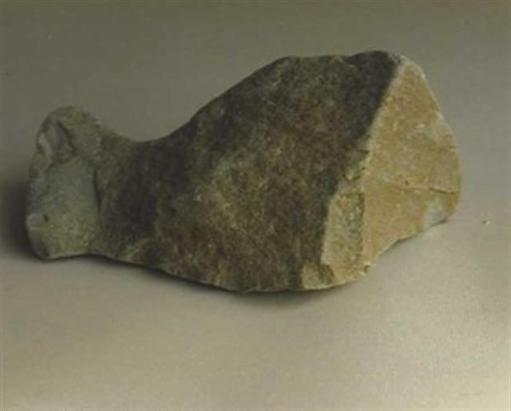
Quarzitischer -Sandstein-Fisch/stylized fish
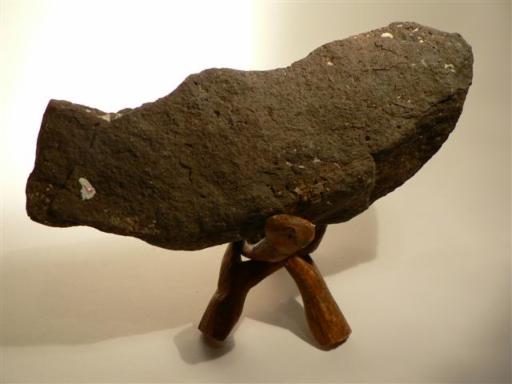
"Lanzarote-Fisch-Form" mit identischer Maul-Kerbe als Gestaltungshinweis wie auf dem Flintstein Kopf eines Fisches von Groß-Pampau, siehe auch Foto unten.
LANZAROTE fish form has an identical marking to shape the head and mouth of the fish, as found on the objects from Gr.- Pampau, Germany.
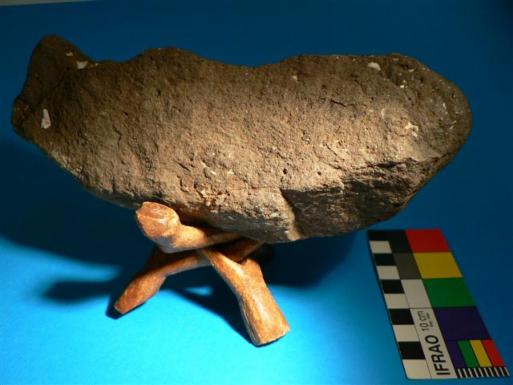
This fish sculpture was a sample find from the beach area of Lanzarote, because of the identical traces for workman ship, a find recognized similar to one in the gravels of Gr. -Pampau.
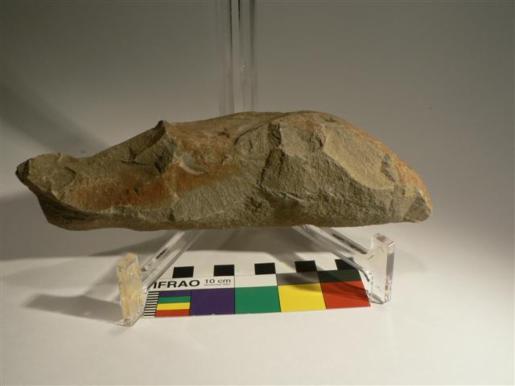
Eine identische Fisch form wurde von Arsen Farad. in einer Sammlung - see EXPERTISE - LINK in Amerika entdeckt. / A very similar shaped fish was discovered in a different collection in America, by Arsen Faradj.
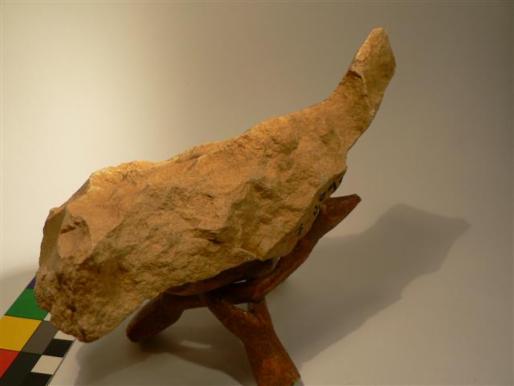
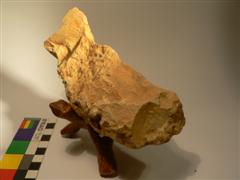
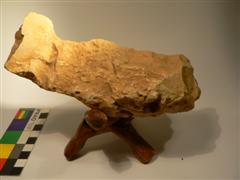
Ebenfalls eine Sandsteinfigur mit typischen Fischmerkmalen. / A typically fish form in another sandstone material.
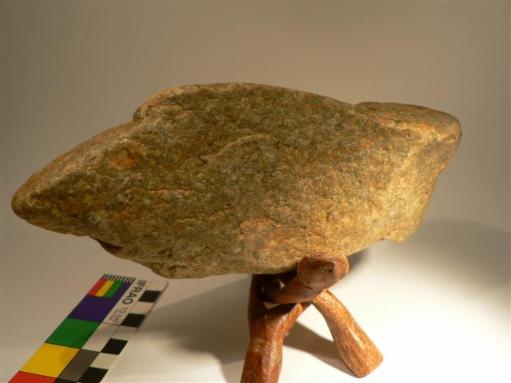
HAI mit "gefärbtem Auge" und deutlich gestaltetem Maul. 4 Fotos mit Schwerpunkt auf Auge und Maul./ SHARK with coloured eye and shaped mouth part, see next 4 photos
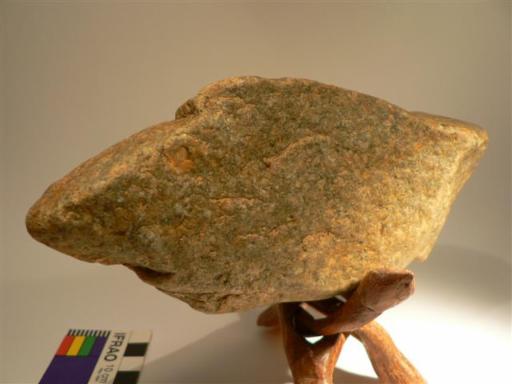
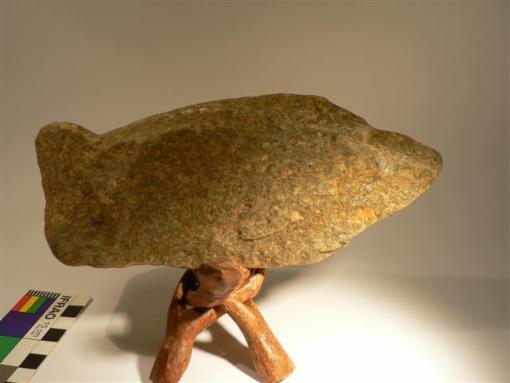
Rückseitenansicht und Foto unten: Vorderseitenansicht/back-and front view-photo below.
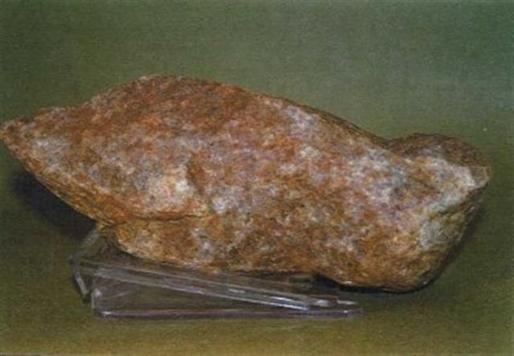
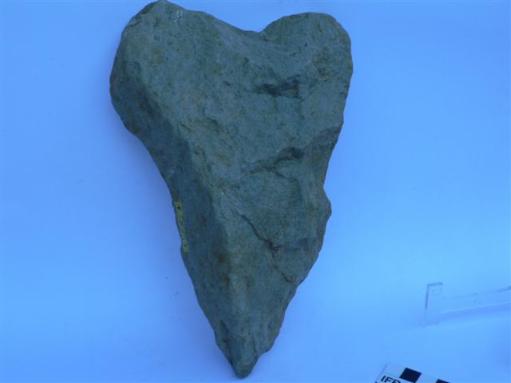
Seit 1986 im Bestand hier, erinnert dieses große Fundstück in seiner Kontur an einen Hai-Zahn, nachgebildet in Basalt.
Basalt stone find, since 1986 component of the assemblage and reminds of a shark-thoth.
ZU DEN ELEMENTEN DES WASSERS, ABER AUCH DEM LAND ZÄHLEN DIE NACHSTEHEND ABGEBILDETEN GESCHÖPFE:::::::::::::::::::::::::::::::::::::::::::::::::::::::
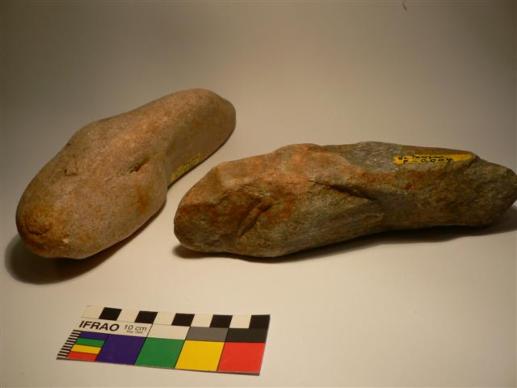
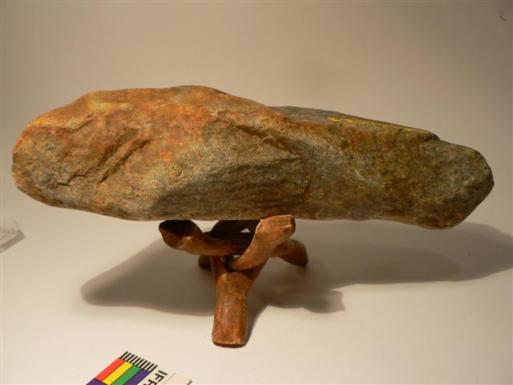
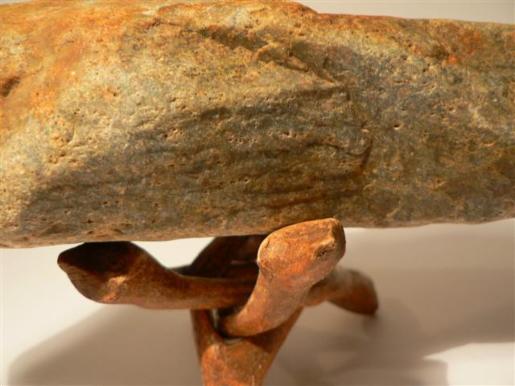
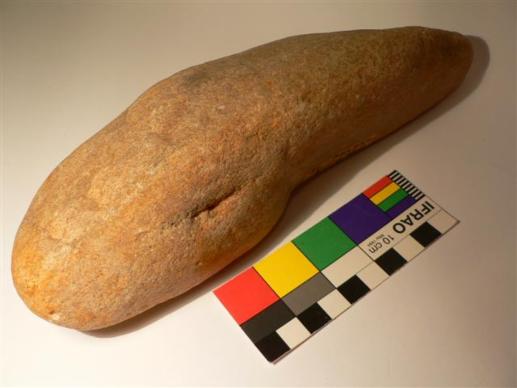
Kaulquappe/ larger tadpole in sendiment stone. The ancient Egyptians probably chose the toadpole to show the NUMBER 100 000 for this type of picture symbol, because there are always so many of them swimming together.
Auch diese Tierart hat als Schriftzeichen Eingang in die heiligen Glyphen (Hieroglypen) des alten Ägypten gefunden. Dort hat man wahrscheinlich, wegen der in Mengen (Schwärmen) auftretetenden kleinen Tiere, diesen eine Zahleinheit gegeben. So bedeuted dieses Bildzeichen die Zahl 100.000.
DIE KAULQUAPPE ODER AUCH TOADPOLE HAT SICH ALS ZAHLENZEICHEN IN DEN HIEROGLYPHEN VEREWIGT; EBENSO EIN WEITERES ZÄHLZEICHEN: DIE FINGER:
WEITERE HINWEISE ÜBER DAS SPEZIELLE SYSTEM DER ALTEN ÄGYPTER ZAHLEN ÜBER BILDZEICHEN AUSZUDRÜCKEN SIND F I N G E R
ADDITIONAL INFORMATION ABOUT THE ANCIENT EGYPTIANS SPECIAL SYSTEM OF WRITING NUMBERS
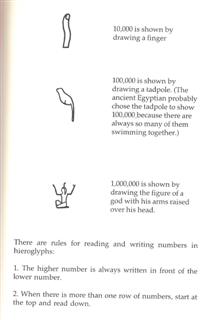 Seite 68 "Writing numbers" British-Museum Publication.
Seite 68 "Writing numbers" British-Museum Publication.
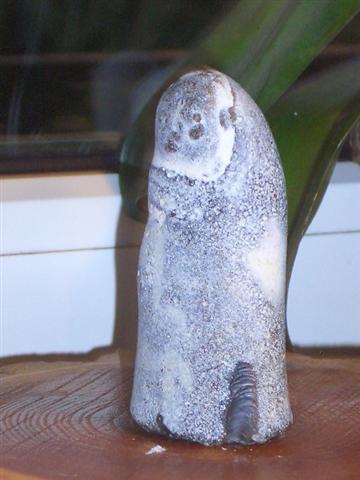 Ein "Ostsee- Finger", als ZÄHLSTEIN
Ein "Ostsee- Finger", als ZÄHLSTEIN
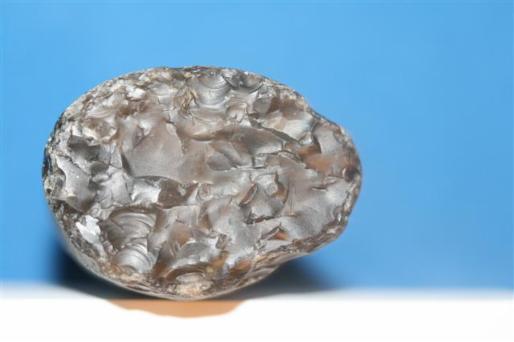
photo Kurt Kocher: Unterseite des "Fingers"
FRAU HELGA KOCHER AUS BAD DÜRKHEIM, fand diesen 7.9 cm langen u. 2.8 cm dicken, sauber abgetrennten "Finger aus Feuerstein", 1999 auf der Ostseite der Insel RÜGEN unter den Strandgeröllen. Herr Kocher ist der Meinung, siehe Unterseitenfoto, dass die Abtrennung des "Fingers" erst in der Jungsteinzeit erfolgt sein könnte, lt. einer elektronischen "mail" vom 23.2. 2010.
Ein weiterer Fund dieser Art gelang in den Niederlanden im Jahre 2001, jedoch hat man dort das Stück nicht als Schriftzeichen erkannt. Der Fundplatz von Gr.-Pampau lieferte leider kein vergleichsweises Exemplar und ist auch nicht von anderen Sammlern, damals meinem INTERNATIONALEN STUDIER ZENTRUM (1992 - 2002) als Thema gemeldet worden. Der Fingerfund von Frau Kocher, erst jetzt 2009 vermeldet, wäre damit der erste Beleg dieses Themas für den norddeutschen Raum, und Ostsee.
In the system of " writing numbers" was a finger mentioned, but not found at this site of Grand Pampau. Learning now, 10 years later from a Baltic-Sea find 1999, in the gravels of the Island of RÜGEN, this flint object above was discovered by MRS. HELGA KOCHER, Bad Dürkheim, southern Germany. A finger find from the Netherlands came to my attention 2001, but was from there never seen as an object about ancient writings. Since no sampling was reported during the times of my INTERNATIONAL- STUDY-CENTRE here (1992-2002), this Baltic-Sea find is of special Interest for the northern Part of Germany here now.
Flusspferde von Gr.-Pampau
Diese Formengruppe hat eine Anzahl von Typen erbracht, deren Merkmale wiederholt im Stichprobenmaterial auftauchten und damit neben Affen, Elefanten nun eine weitere Spezies der afrikanischen Fauna in den Kiesen aus Norddeutschland belegt. Die Entschlüsselung dieser Tierart erfolgte ohne Hinweise, gar Vorlagen von anderen Sammlern und ist für meine Untersuchung damals unbekannt gewesen. Über eine kleine Auswahl an Gesteinsarten, werden außerdem durch einen schmalen, runden Feuersteinabschlag, die von der Forschung anerkannten Kriterien belegt, die gleichzeitig auch diese Interpretation abgesichert hatte.
This group of an African -animal- fauna, has produced during sampling times next to apes, and elephants also the HIPPOPOTAMUS in a rather diversified material with key elements, helpful for a correct decipherment.No information from other collectors were available and it was the different stone material, allowing an insight in what the sculptorer had in mind, when fashioning these sculptures.Accepted traces for human workman ship are ripple marks on flint, securing the motif and interpretation.
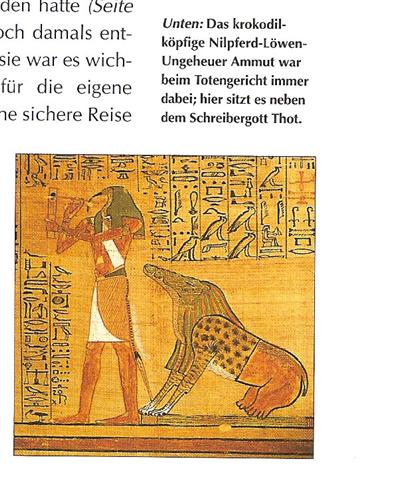 Ein Tier-Ungeheuer aus 3 Tierarten unterstützt einen Schreibergott in den Ägyptischen Mythologien.Hier ist also eine Überlieferung im Verbund mit Bildschriftzeichen festgeschrieben, welches auch bei der Entzifferung der folgenden Bildzeichen helfen kann. Entnommen aus der Sammler Edition "Mythen der Menschheit". IM REICH DES SONNENGOTTES ÄGYPTEN.S. 95 m.frdl.Genehmigung
Ein Tier-Ungeheuer aus 3 Tierarten unterstützt einen Schreibergott in den Ägyptischen Mythologien.Hier ist also eine Überlieferung im Verbund mit Bildschriftzeichen festgeschrieben, welches auch bei der Entzifferung der folgenden Bildzeichen helfen kann. Entnommen aus der Sammler Edition "Mythen der Menschheit". IM REICH DES SONNENGOTTES ÄGYPTEN.S. 95 m.frdl.Genehmigung
Egyptian mythologies "deliver" with the above picture "animal monsters", assembled with features of animals such as crocodile, hippo, and lion, assisting the "god of writing" (Thot) by holding court at times of death. It is a good information offered to read those sculptures as BILDERSCHRIFT, assisting at the same time to decipher the following finds.
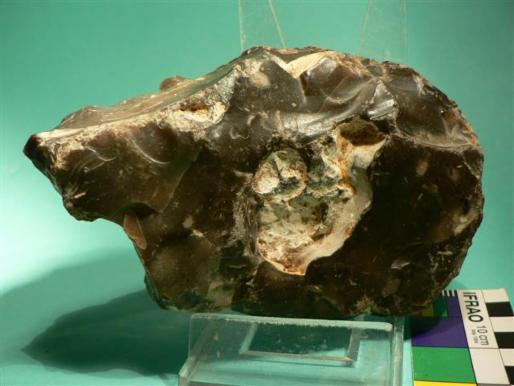
Halbierte Vollfigur mit den rundlichen Formen eines Flusspferdes und mit einem Kopfteil, welches an ein Krokodil erinnert. Eine Flintfigur.
Black flint, half size body, a sculpture with rounded proportionts like a hippo, but with a head part, reminding of a crocodile.
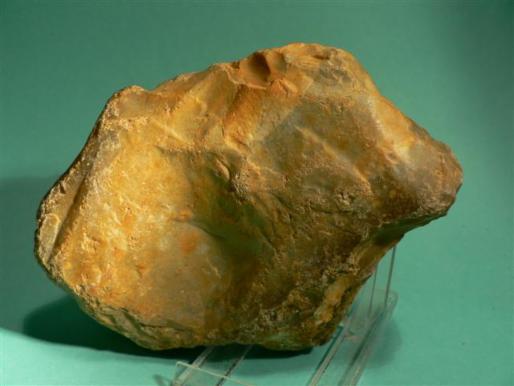
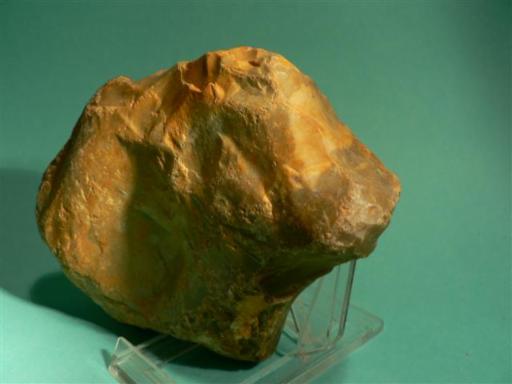
Auch diese Figur ist eine Ganzkörperdarstellung mit deutlichen Merkmalen eines Flusspfedekopfes aus Flint.
This light grey flint is a full body proportion of a hippo with clear head elements of this species.
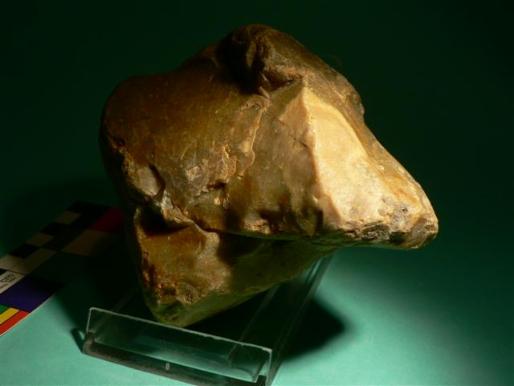
Fast identisch ist dieser Flint- Einzelfund eines Flusspferdes, der sich ausschließlich auf die Darstellung des Kopfes beschränkt und damit das typisch aufgerissene Maul belegt, siehe das untere Foto.
Almost identical is this flint single find of the hippo species, representing the head only with the wide open mouth, see photo below.
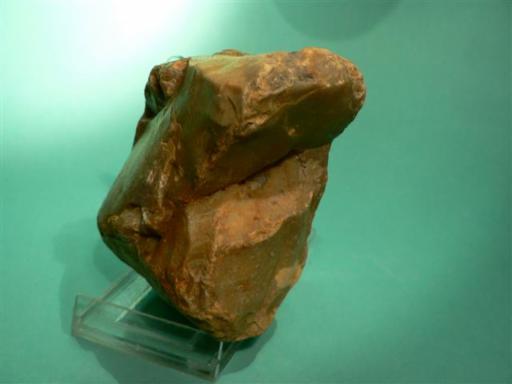
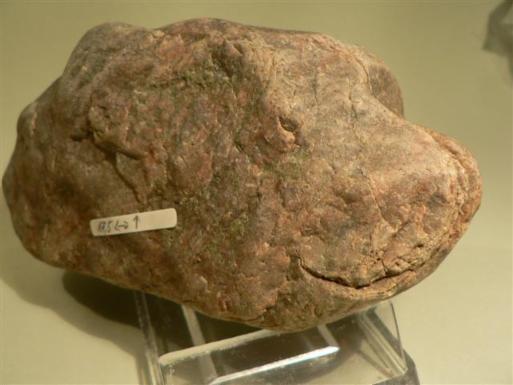
Gut herausgearbeitet is das Rundmaul, das Auge und die Andeutung eines kleinen Ohres, auf diesem Stein.
3 elements of a hippo here well executed by the mouth , small ear and eye.
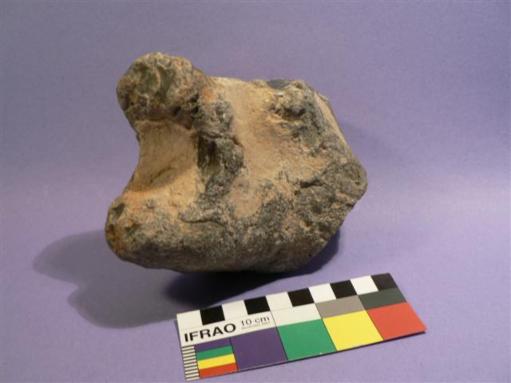
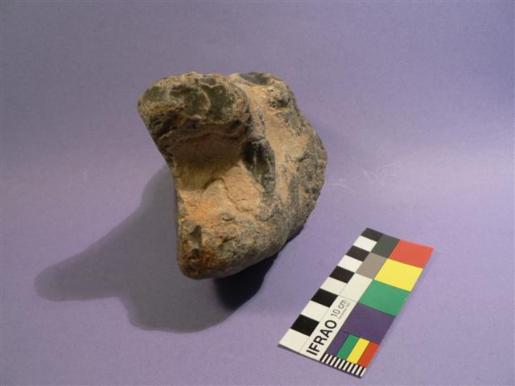
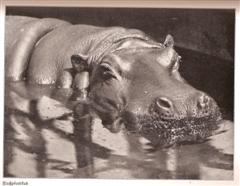
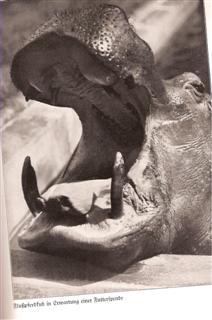
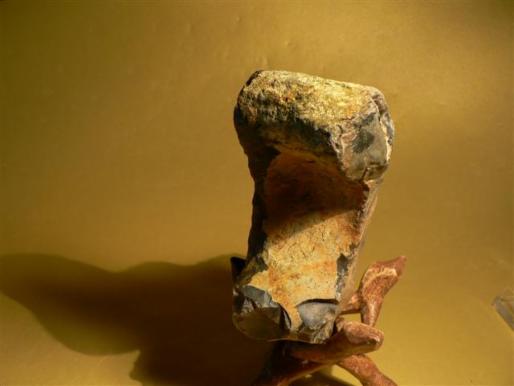
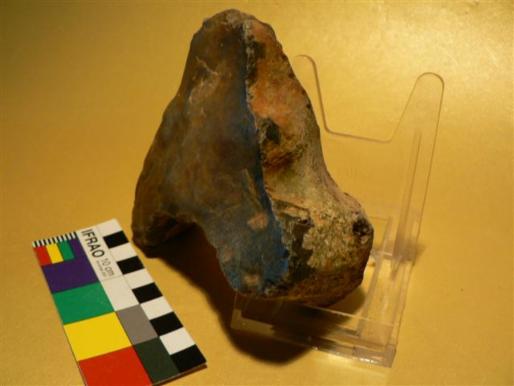
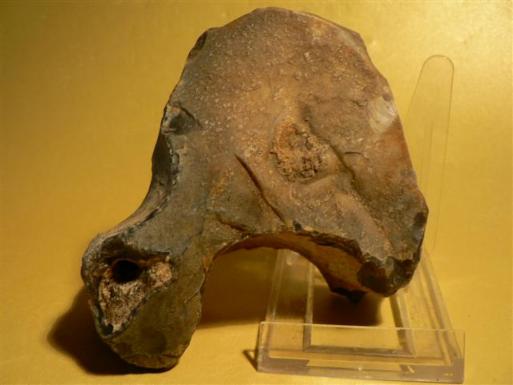
An diesem Steinsplitter ist der große Kopf und das weite Maul eines Flusspferdes zu erkennen, immernoch sein bekanntestes Merkmal. Auch als "Nilpferd" bekannt, wirft es die Frage auf, was hat der "Nil" mit dem "Pferd" gemeinsam? In Kombination sind an dieser Skulptur das Flusspferd links, mit dem Kopf eines Pferdes rechts, dargestellt. Damit ist zumindest für diesen Sprachraum das bildhafte Element des "Flusspferdes" deutlich "lesbar" in einem Bildschriftzeichen nachgewiesen.
Large head and huge mouth are still the dominant features of a hippo and are combined on this stone implement. In German language called Nilpferd the question is: what has the river "Nil" in common with a "horse"? The above flint find shows next to the hippo features also a horse head in profile, thus a "readable" picture sign for a language spoken in this area.
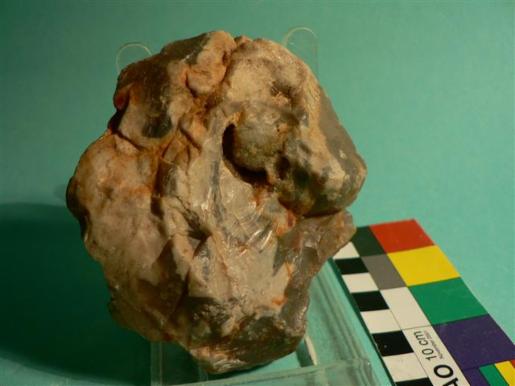
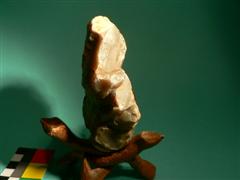 Menschengesicht mit Flusspferd, es ist ein kleiner, 9cm großer und fast runder Stein. Er wirkt wie ein "misslungener Abschlag" durch die kleine Druse im Zentrum. Von der Seite fotographiert erscheint das weit aufgerissene Maul.
Menschengesicht mit Flusspferd, es ist ein kleiner, 9cm großer und fast runder Stein. Er wirkt wie ein "misslungener Abschlag" durch die kleine Druse im Zentrum. Von der Seite fotographiert erscheint das weit aufgerissene Maul.
This core type of depiction shows left side a human face and on the right side appears the head of a hippo, when photographed from the side, the huge open mouth underlines the interpretation.
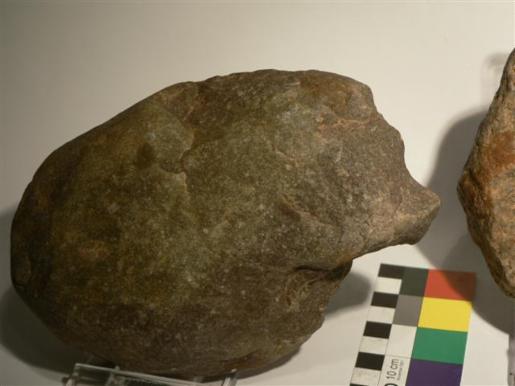
Quarzitstein/Nilpferd, Halbfigur unteres Foto zeigt das Tier im Vergleich zur Bärenfigur./
Hippo in quartzite,photo below shows the same animal compared to a bear sculpture, left.
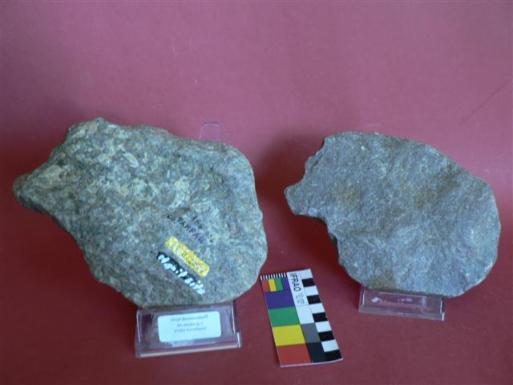
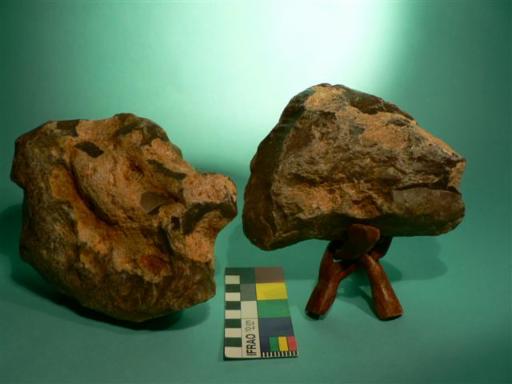
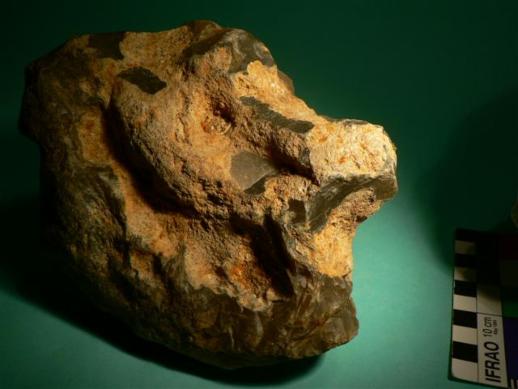
Vor-und Rückseitenansicht/ Front- and back view of one and the same object, showing working traces
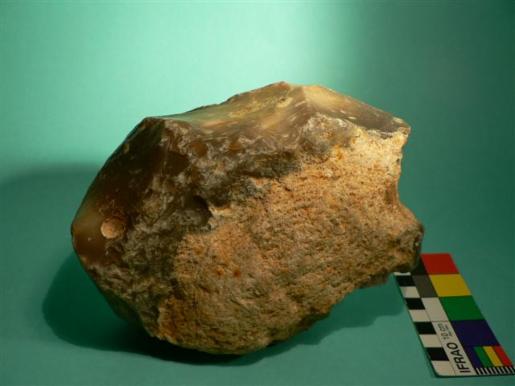
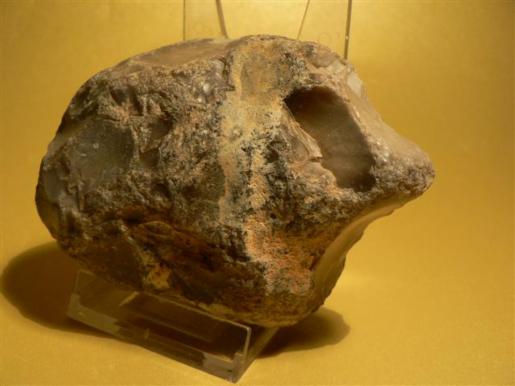
Ein doppelseitiges Fundstück aus Flintgestein, hat auf der Rückseite die Gestalt eines Igels. In der alphabetischen Reihenfolge, steht hier das HIPPO in korrekter Reihenfolge mit dem IGEL, also die Lautwerte H und I als Bildschriftzeichen. Siehe dazu Kapitel IX.
This poloymorph object has on one side the hippopotamus "Gestalt" and shows on the backside the a hedgehog, called in german language IGEL, it is presented on chapter IX. Here the sequence of letters "H" for hippo and "I"for Igel or hedgehog is in proper unity of picture reading.
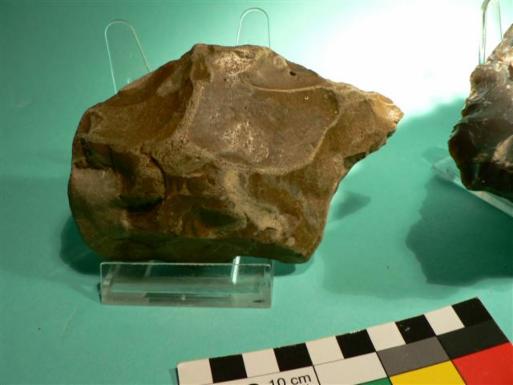
Brauner Feuerstein, seine Form hat figürliche Elemente als auch "Werkzeugähnlichkeiten" wegen seiner Spitze. Diese Spitze ist nicht ganz unüblich an vielen Objekten, aber ist oft nur einfach eine "Steckspitze" oder fungiert als Richtungsweiser? Deutlicher dagegen ist das nächste Objekt, hier hat die Spitze unzweifelhalft Merkmale für eine Flusspferd-Darstellung.
Brown flint has next to figurative elements also "tool-type" similarities, due to the conical section. Such sections are found on many of the sampled material and have often a fuctional purpose or even are used to give directions to be viewed. The next flint stone however has much clearer information, how to read the conical form as a hippopotamus animal.
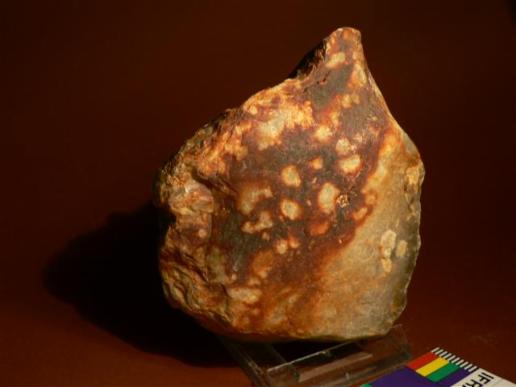
Werkzeug aus Flintstein mit Gesicht? Die Antwort findet sich in den folgenden 3 Fotos. Hier wird ein Flusspferd dargestellt mit einer bereits bekannten Gesichtsikone, Farbanhaftung und Maulkerben, die sich auf anderen Gesteinsarten, wie Quarzit, wiederfinden lassen.Vgl.dazu relevante Fotoserie unten.
A "stone tool" with a facial impression? The answer will be found when studying the next 3 photo impressions. Here a hippo is shown, with colour traces, a typical mouth carving is found also on quartzite sculptures, presented for comparing.
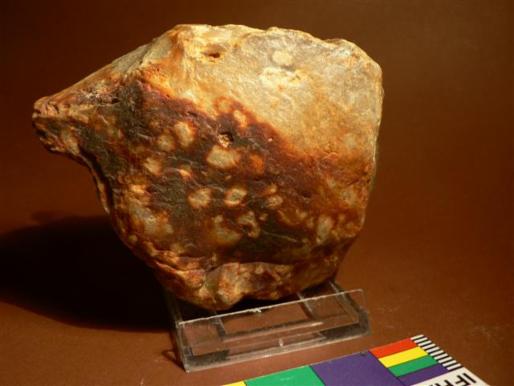
Objekt gedreht 45° zeigt die Spitze nun eine Tierskulptur in Seitenansicht an, wobei sich linksseitig eine Kerbe zeigt, die auch auf weiteren Darstellungen dieser Tierart auffällig ist.
The groove left side to the mouth is a repeated mark on some of the hippo-sculptures from this site and can be observed on the quarzit find as well.
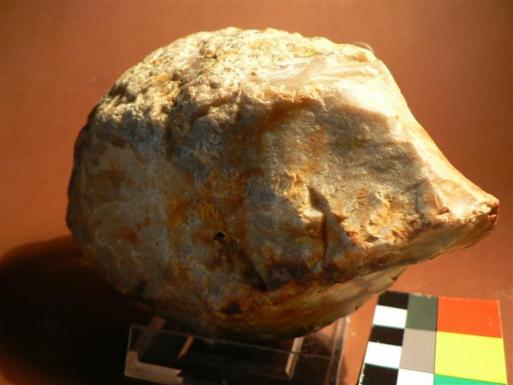
Feuerstein-Nilpferd und mit der typischen "Maulkerbung", links.13cm Länge.
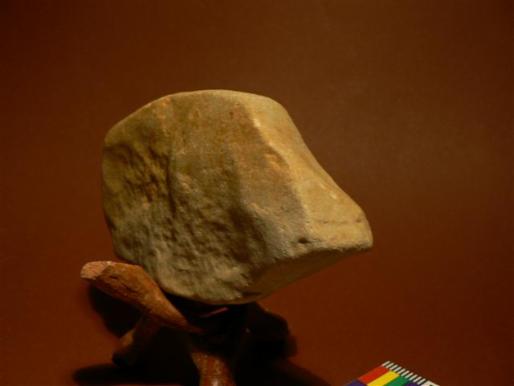
Ein quarzitisches Fundstück hat im Gegensatz zum vorangestellten Feuersteinstück eine Augenmarkierung, aber die gleiche Maulkerbung, linksseitig,hier nun ein Merkmal dieses Fundplatzes von Gr.-Pampau.
Ein ganz ähnliches Stück ist völlig unabhängig von Dr. James Harrod, Maine, USA auf der paläolithischen Fundstelle von HAR KARKOM, Israel entdeckt worden; VERGL. die folgende Foto-Serie.
This quartzite find of a hippo from Gr.-Pampau, carries an "eye depiction" , but at the same time also the mentioned "identical groove" at the mouth.
A HIPPOPOTAMUS DEPICTION FROM HAR KARKOM SITE; ISRAEL
The researcher Dr. James Harrod, Maine , USA reports independently to those discoveries here, a very similar find at the pal.site of HAR KARKOM, Israel; FOR MORE INFO`s PLEASE VISIT HIS WEBSITE - ORIGINS NET- SEE LINK AT THIS WEBPAGE.
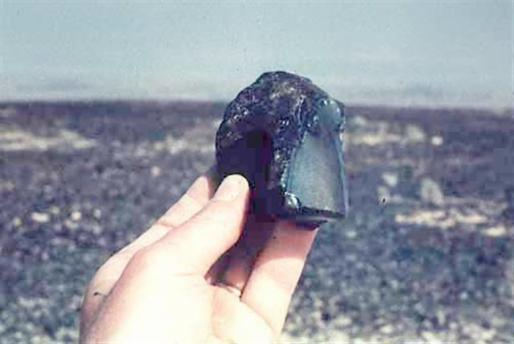
Photo: Dr. J.B.Harrod
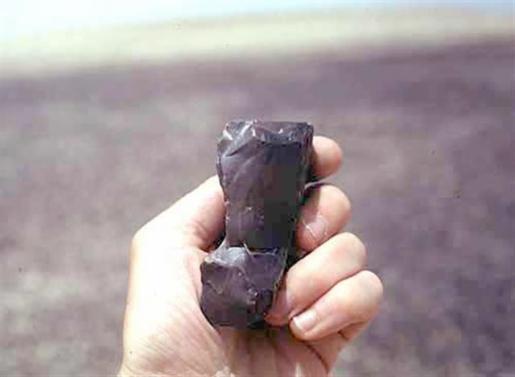
Photo: Dr. J.B.Harrod
DETAIL-ÜBEREINSTIMMUNG IST AUCH HIER DAS AUFGERISSENE MAUL MIT ZAHNANDEUTUNG. Auf der Seitenansicht des Objektes zeigt sich der Kopf eines Pferdes oder Elefanten.
AGAIN DETAIL SIMILARITIES on objects discovered HERE: WIDE OPEN MOUTH AND INDICATION OF 2 LARGE TEETH TOGETHER WITH an IMPRESSION OF THE "HORSE HEAD" OR "ELEPHANT" in SIDE VIEW.
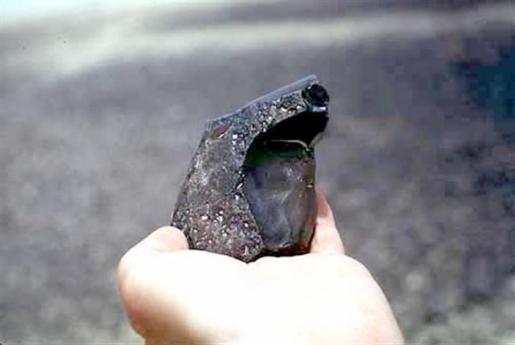
Photo: Dr. J.B.Harrod
NILPFERD-FIGÜRCHEN IN FLINT
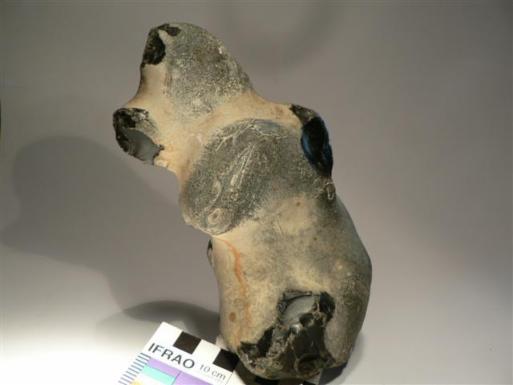
Vorder- und Rückseitenansicht eines Nilpferdfigürchens
Front and back view of a hippo-sculpture in flint.
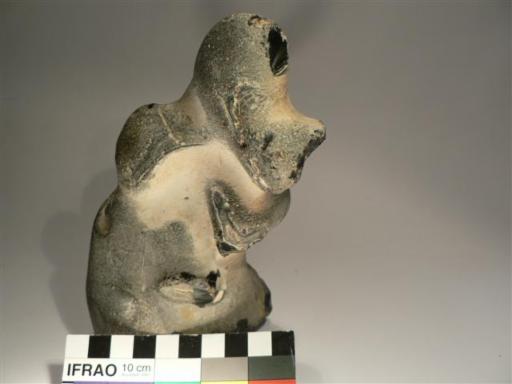
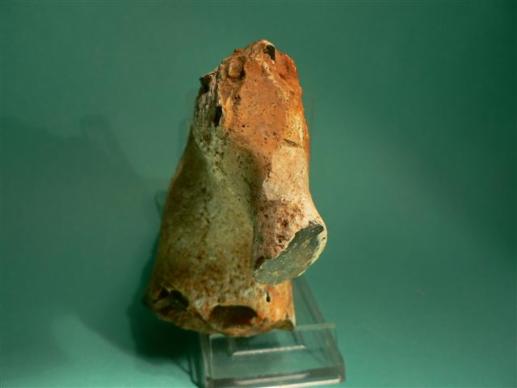
Stilisierter Flusspferdkörper, hat identische Abschlagspuren wie das vorangestellte Figürchen und zeigt zusätzlich die Andeutung von Füßen. Das Stück wirkt einseitig eingefärbt.
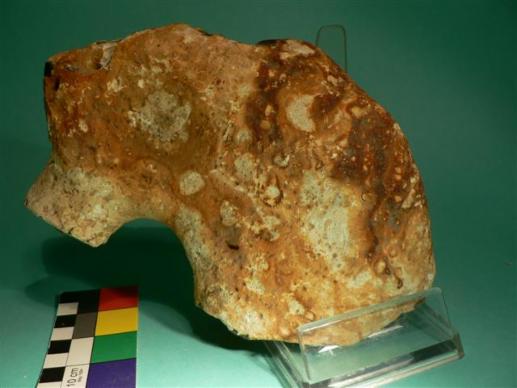
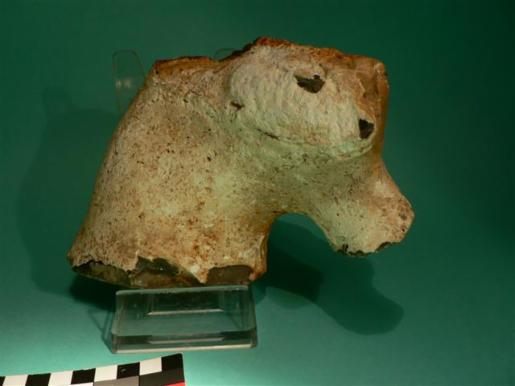
Rückseitenansicht / Back side view
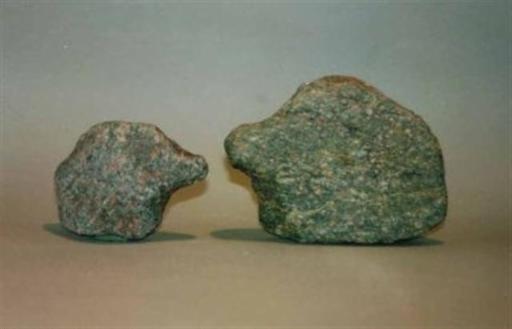
Flusspferdbüsten in unterschiedlicher Größe, eine mögliche Mutter und Kind Darstellung? Busts of hippo figures small and large like mother and child presentation?
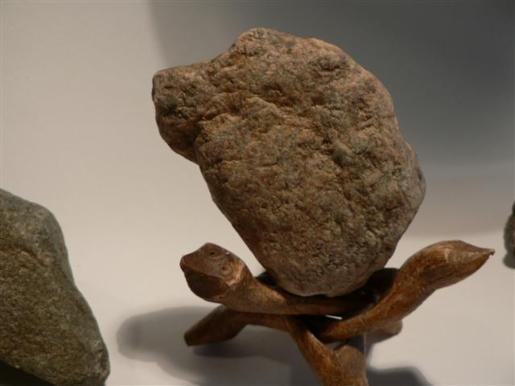
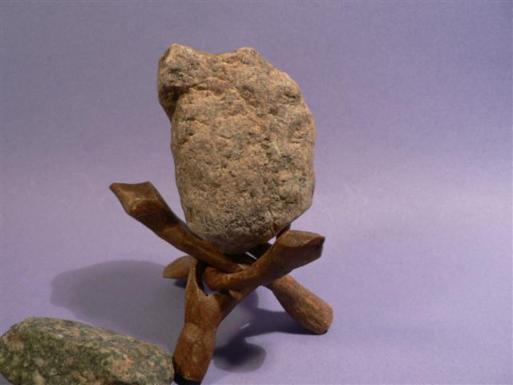
Granit- Flusspferd in vertikaler Position.Vertical position hippopotamus.
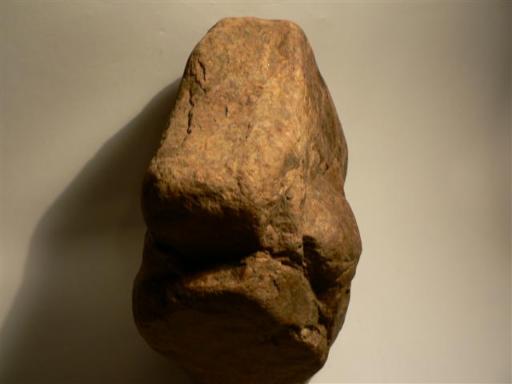
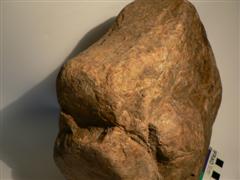
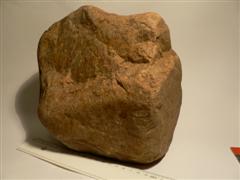
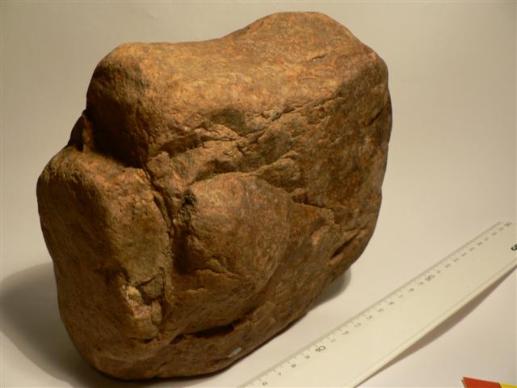
Dieser Granitblock hat eine Größe von ca. 21cm, und kann mit seinem schweren Gewicht kein beweglicher Gegenstand gewesen sein. Den noch größeren FINDLING habe ich nicht entdeckt, aber die Motivhäufigkeit und die unterschiedlichen Gesteinsarten, in denen dieses Tier dargestellt wurde, läßt den Schluss zu, diese GESTALT war stationär dort "verankert".
This heavy rock block in granit material is about 21cm large, the head of the hippo is the dominant feature all around. Due to it`s heavy weight, this object was in a stationary position, considering ALSO the many smaller art objects sampled in diversified stone material. Unfortunately the larger MENHIRE SIZE was not documented by photo at this site.
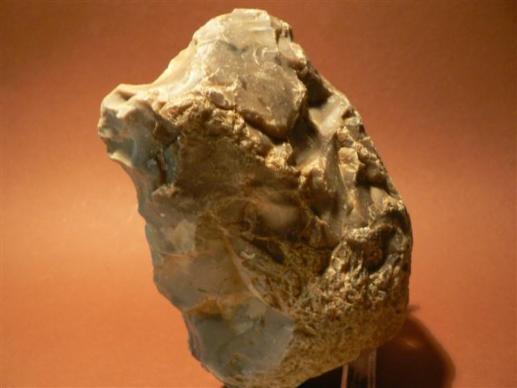
15cm großes Feuersteinstück, unten mit Rückseitenansicht und anerkannten Schlagmerkmale für Feuerstein. Das Stück hat, wie das kleine Granitobjekt, eine schematisierte Gesichtsikone.
Vertical position of a large find 15cm in size, found in flint with a schematized facial impression and accepted criteria for human workman - ship.
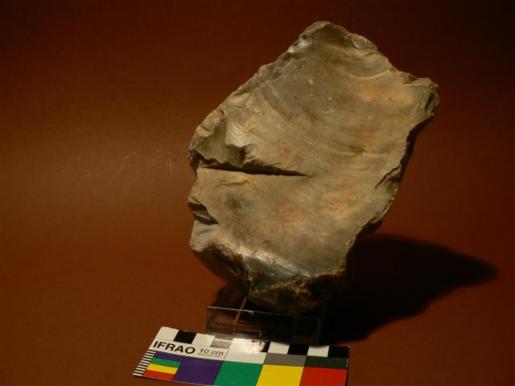
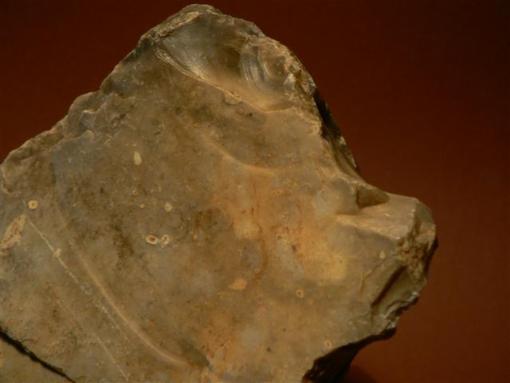
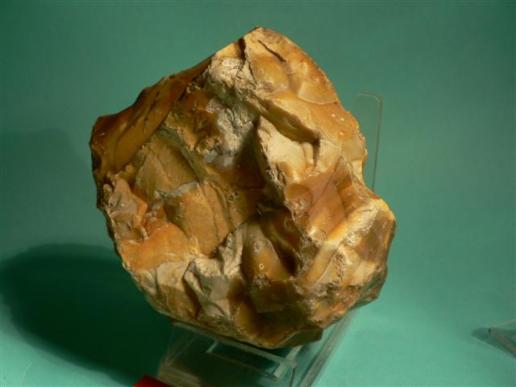
Kopf eines Flusspferd-Bullen.Das Pferd liegt als "Schattenfigur" nach links ausgerichtet.
Head of a male-hippo, the horse-head appears to the left as "shadow picture".
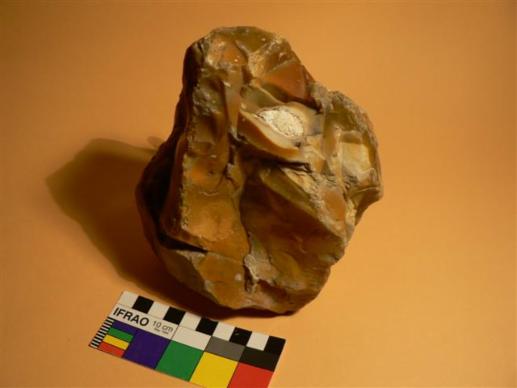
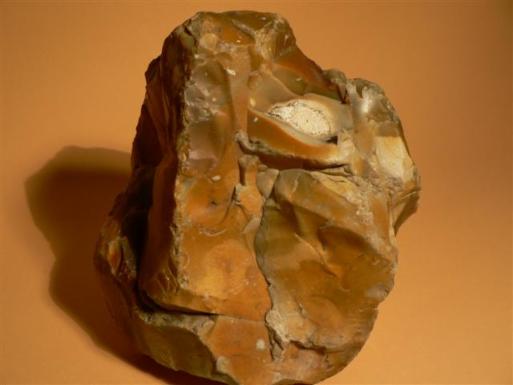
Der Flusspferd-Bullenkopf hier nun von der Rückseite betrachtet.Eine bekannte Masken - Ikone erscheint oben mit 2 weißen Flecken als Augen. Es erinnert an die Sonnen- und Monddarstellungen innerhalb dieses Fundmaterials, durch die "geöffnete Augenlid Darstellung und dem geschlossenen weißen Augenfleck.Eine lange, im Winkel geschlagene Nase hat oberhalb eine Gesichtsdarstellung und viele Rüsselteile, die auch von unten nach oben, sowie von links nach rechts, als Hand und Arm gedeutet werden könnten. Diese Masken-Ikone ist hier mehrfach zu beobachten bei den Nil-oder Flusspferd-Skulpturen.
The "hippo-bull-head" now viewed from the back-side. A well known mask with 2 white markings appear on the upper right side. They are iconographical informations for sun and moon within this assembled material, mostly depicted also as an open and closed eye lid. In addition a long "nose" covers almost the length of the stone, on top is a human face but the flint is "broken" in such way, giving the impression, as if "trunks" are spreading from top to bottom,left to right side and even from bottom to above. The "long nose iconic" is repeated, compare next implements.
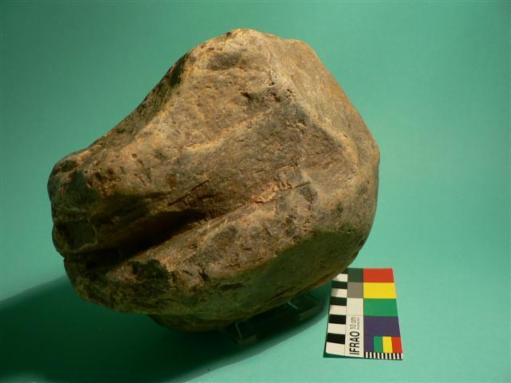
Fast 18 cm groß ist dieser Flußpferdkopf und war schon ein erster, deutlicher Sammelfund für diese Tiergattung. Unklar blieb die untere Maske,welche hier durch eine tiefe Kerbung vom Kopf des Flusspferdes getrennt ist.Sie ist "einäugig", und nur mit wenigen Farbpartikeln anhaftend. Erst ein sehr viel später erfaßtes Stück aus Feuerstein/Hornstein, wiederholte diese "Maske". Vergleiche die folgenden Fotos.
Sediment stone artifact of 18 cm size, was one of the very first objects found for this animal species. The "mask" with "long nose", and "one eye", seemed common for this sampled site, as well as the colour traces. But it was a much later sampled horn-flint-artifact, that repeated the motif. (see next photos).
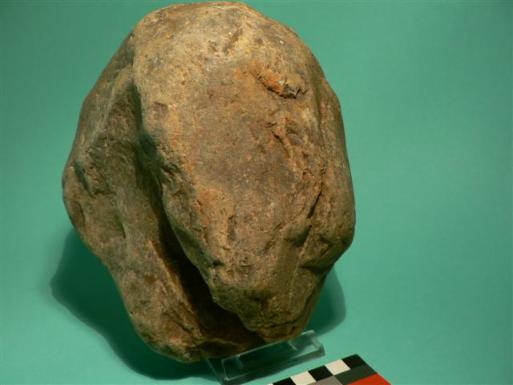
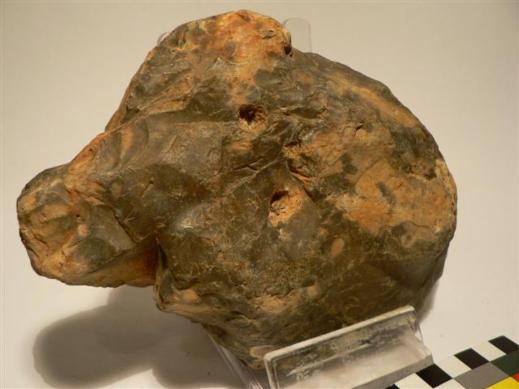
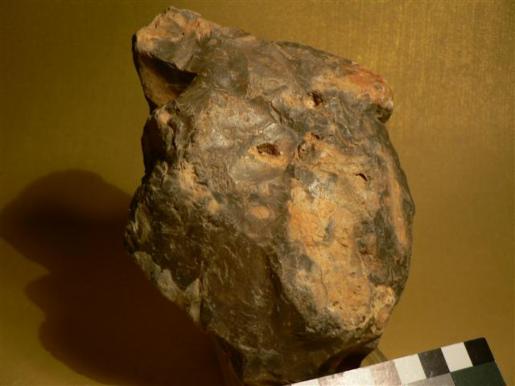
Nicht immer sind die Gesichtsdarstellungen auf solchen Steinen allein durch deutliche Abschläge gekennzeichnet, vgl. dazu das vorangestellte Foto. Dieser Hornstein hat ein großflächiges "Gesicht" wie eine Maske (rechts als 3/4 Profil)aus natürlichen, durchscheinenden Farbelementen. Eine Flusspferd- Glyphe.
Sculptures of pal. tradition do not always show artificial modification, by the "human hand" like shown on the flint artifact prior. Tracing this "hippo" for anthropic markings of human faces, one has to take also "x-ray art" into consideration. The 3/4 facial mask is flanked by several smaller size "faces", indication is a "white spot" for the long nose and a small horizontal line for the mouth.
Der nächste "Kopf" ist ein weiteres Beispiel.... for example see the next object.
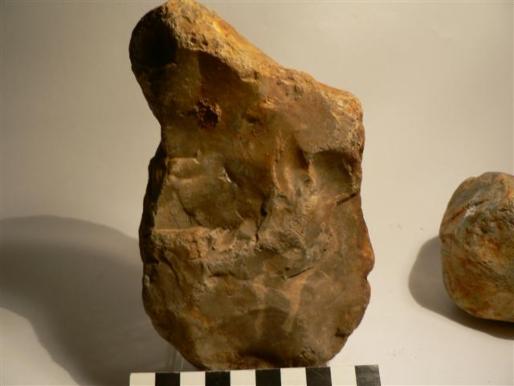
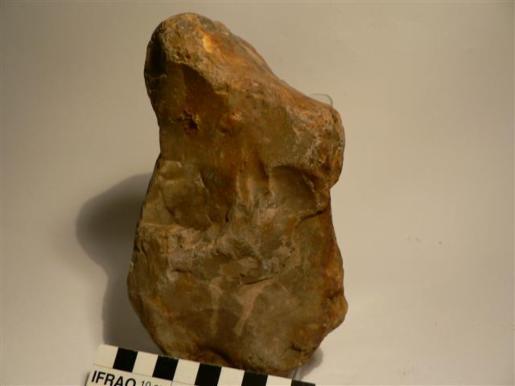
Um hier nun das Profilgesicht zu erkennen "verliert" die Nilpferdglyphe, von 17cm Größe, seine "Dominanz". Ein fast gleichgroßer zweiter Fund ist nur als Pferd zu deuten (siehe Foto unterhalb), hat aber keine Gesichtsteilmarkierung. Das Stück wird dazu unter den "Pferde-Darstellungen" nochmals von der Rückseiten-Ansicht gezeigt. So sind die Übergänge bei diesen Figuren fließende. Oft bleibt als Merkmal nur eine einheitliche Gesteinsauswahl mit gleichen Größenabmessungen oder die deutliche Maulkerbe, um Zusammenhänge und damit ihre Zuordnung zu gewährleisten.
The dominant reading of a hippo - glyphe is lost. Compare the facial impression to the right, the hippo theme has now the position of a "head-dress" only, but together with another single horse sculpture in identical material and size , this mutual theme is established again for a correct "reading".
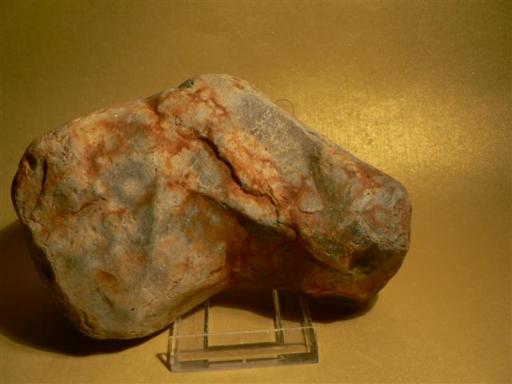
Ein Pferdekopf in Maßen von 17 cm Länge, fast 8cm Stärke und in einer gleichen Gesteinsart, wie das vorangestellte Nil-Pferd.Beide Stücke sind als Einheit lesbar.
Zoomorph object of a horse, will be presented from its back side under a different page of this website. Technical measurements:17 cm at length,8cm wide. Booth items are a "unit" in size and stone material choice; BOTH together are still "readable".
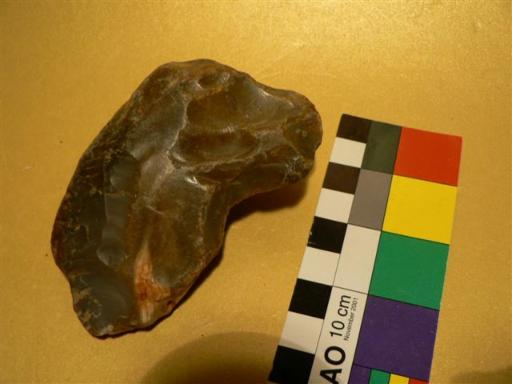
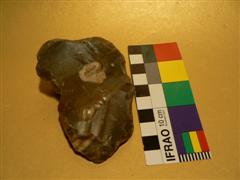
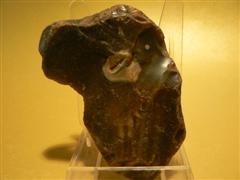
Kleiner Feuersteinabschlag, mit Ähnlichkeit zum Granit-Flußpferd, traditionell als "Werkzeug" eingestuft, überwiegt hier jedoch die Bildhaftigkeit, wie auch am folgenden Abschlag.
Traditionally evaluated as a "tool" flake is the hippo impression dominant. This is also evident on the following implement.
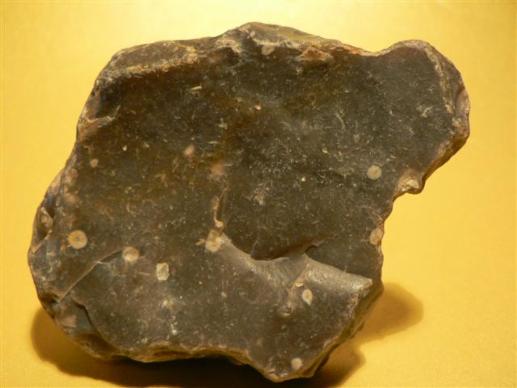
Flusspferddarstellung zeigt den typischen Kopf und BEIN mit (HINTERSCHENKEL)des Tieres aber als Pferdefuss lesbar. Der kleine Abschlag hat Rückseitig klare Eingriffsmerkmale und eine Kortexbildung.Vgl. das Foto unten mit 3 Fundstücken in identischer Cortexausbildung. Gut durch eine Delle gekennzeichnet, kann man den Kopf des Flusspferdes gegenüber der Kopfausbildung einer Bärenfigur, unterhalb der Collage, unterscheiden.
Silhouetten impression of a hippo head, hind leg and foot of a horse. Back side has clear working traces and a cortex, like photos below. In direct contrast are 2 figurations in identical cortex showing the hippo head to be compared to the bear sculpture standing below.
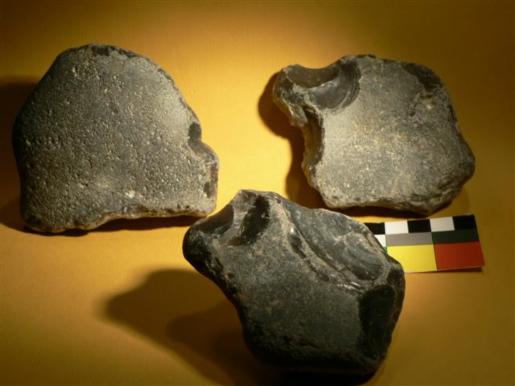
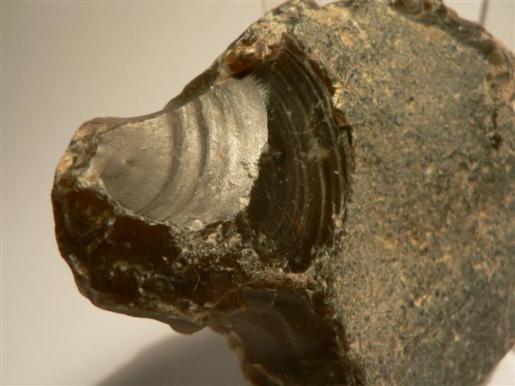
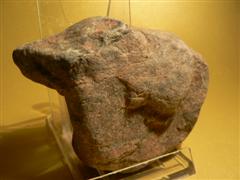
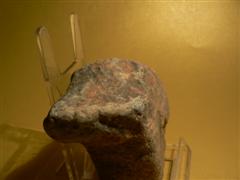
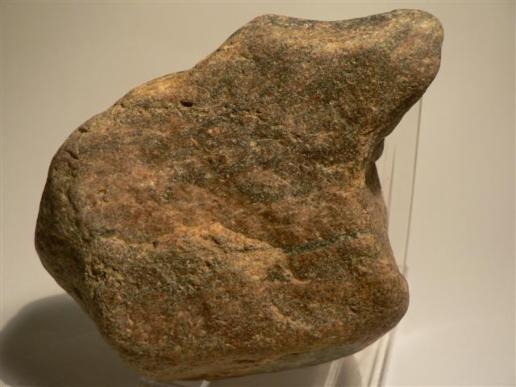
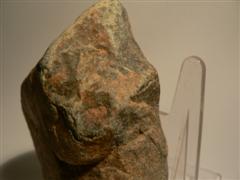
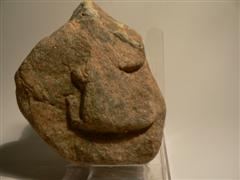
Vergleichsarbeit über andere Gesteinssorten mit Formenidentitäten. Hier eine Darstellung mit verschiedenen Elementen, wie Breitmaul in Frontalansicht und Masken-ANDEUTUNG EINER FRONTALANSICHT DES FLUSSPFERDEKOPFES.
Comparing different materials to flint, see form- or shape identities as well as mask indicating the FRONT VIEW of the wide HIPPO - HEAD.
NOCH MEHR "WERKZEUGE" MIT STARKEN FIGÜRLICHEN ELEMENTEN.....more "tools" with strong aspects of a dominant figuration.
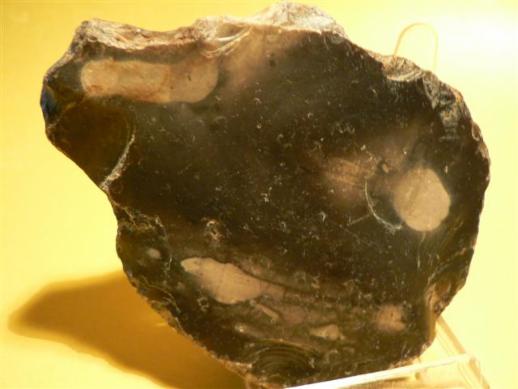
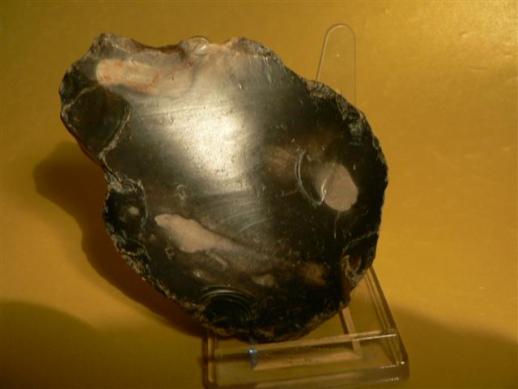
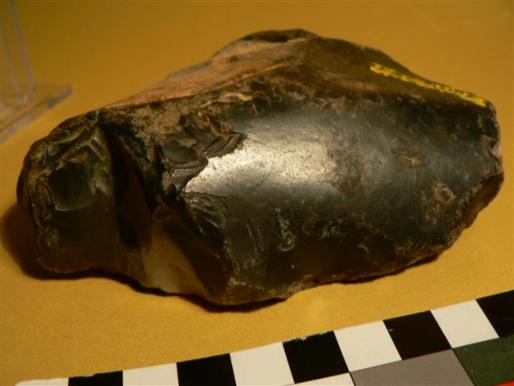
Flußpferd mit Schildkröte im Verbund. Das Originalstück ist ein Abschlag, die flache Unterseite zeigt die Schildkröte, doch die Umrissform hat wieder FLUSSPFERD CHARAKTERISTIKEN.Beide Tiere leben im Wasser.
In combination a type of "flake", traditional interpretation a "tool", here combined now with the image of a turtle and a hippo impression, all on one object. However the overall shape is one of the hippo, but when turned up side down, a short neck of a "baby turtle" becomes evident.Both animals represent "water" as their enviroment.
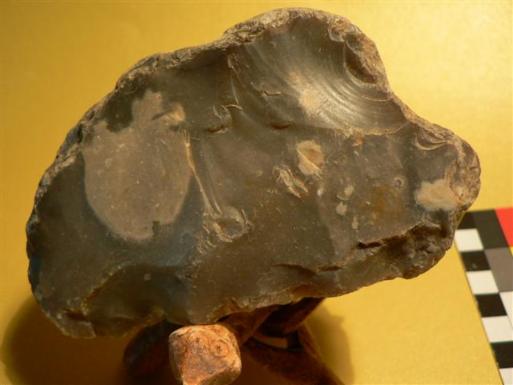
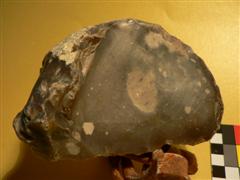
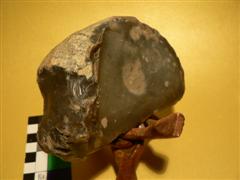
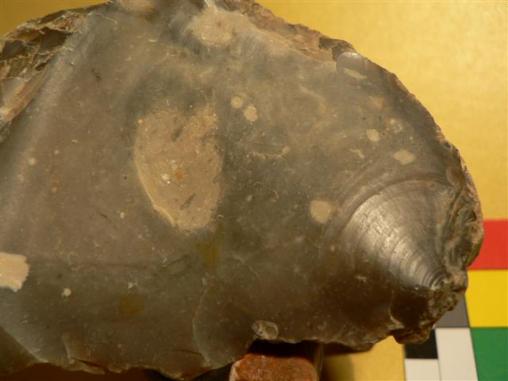
Zitruslamellen-Abschlag, Vorder-u.Rückseitenansicht, sowie Bulbus (Schlagzwiebel)Größe:12cm lang, 4 cm breit an seiner stärksten Griffseite -oben-. Das Stück liegt gut in meiner nicht sehr großen Hand, und hat sogar Fingerkerben dafür. Möglich, dass es als "Schaber" gedacht war, aber ob es nur deswegen einen Werkzeug-Charakter haben soll, bleibt offen, der figürliche Aspekt ist ebenso stark ausgeprägt. Es gibt sogar eine Umrissform einer Schildkröte, einbezieht man die nicht immer deutbaren weißen Flecken im Gestein.
Zoomorph impression in the form of a citruslamella "flake". Presented is the left and right side view and the bulb of percussion. The widest part on top is about 4cm and length: 12cm. The object is fitting well into my small hand, has even a carving for my finger. The tool aspect, like for instance a "scraper" is well possible, but the figurative aspects are at least as dominant if one considers the white outlined turtle contour on the side of the first photo impression.
3-er Impression auf einem "Teller-Abschlag"
...lesbar werden Afrika-Gnu, und Flusspferd mit extra Andeutung des "Pferdekopfes", welcher mittig, oben zu entdecken ist.
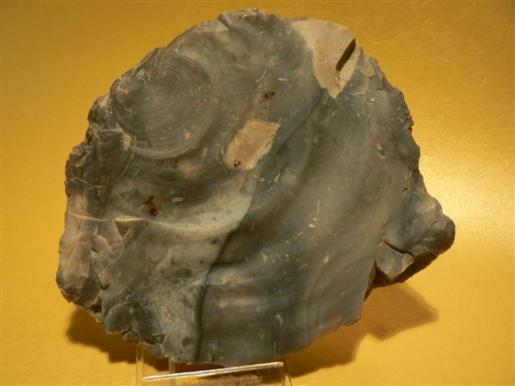
Schlagwellen auf diesem dünnen Feuersteinabschlag. Interpretation: Blaues-Gnu,hier ist die Wellenführung in Übereinstimmung mit dem Gehörn(vgl. Abbildg) und auch mit dem Körper eines Nilpferdes.
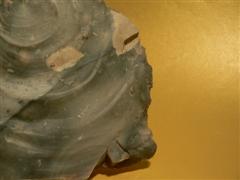
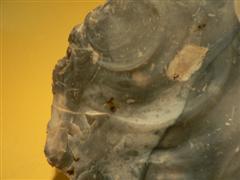
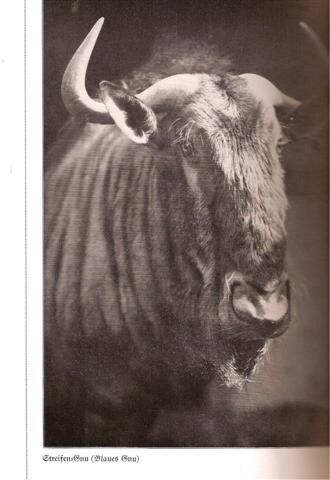
Engl.
Razor blade sharp and very thinn is this flint stone slab with lines of artificial detachment, showing a hippo head to the left and a possible GNU. The horns of the GNU are indicated by the ripple marks but are at the time features of the hippo.
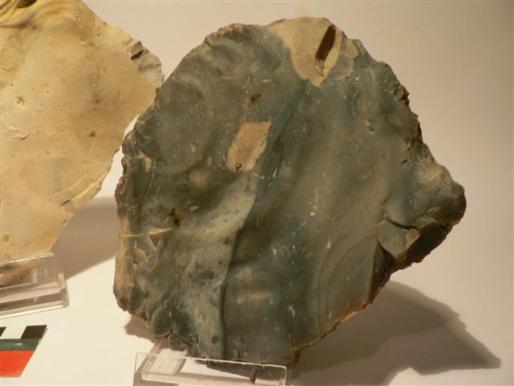
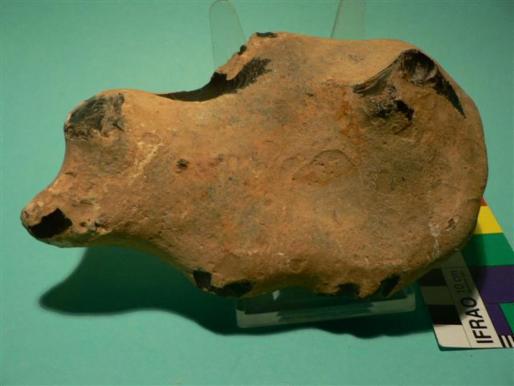
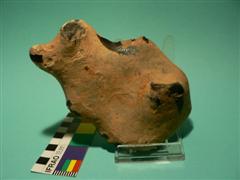
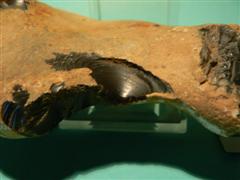
Abstrakte Darstellung eines Hippopotamus. Der gewollte Eingriff ist mittels der Schlagnarbe dargestellt. Ansonsten ist es bei solchen Einzelfunddarstellung dieser Artefakt-Kategorie oft recht schwer, eine annähernd richtige Interpretation vorzunehmen. Mittels der aufgebauten Einzel-und Kombinationselemente des THEMENBEREICHES, wurde eine Interpretation möglich. Nun ist somit KEINE "Bärenmutter mit Kind" unterwegs, sondern eine Hippo-Darstellung gewollt, bei der eine zusätzliche Darstellung eines Pferdekopfes auf dem Rücken den Hinweis auf eine Nil- oder Flusspferd- Skulptur ergibt. Ebenfalls ist eine Vierfüßigkeit zu erkennen, ein lesbares Bilderschriftzeichen.
This is a more abstract version of a Hippopotamus presenting a minimiced alteration, a bulb of percussion is representativ for accepted human modification. When sampled as single find, the interpretation is often difficult, but with the foregoing examples, sufficient material assisted to "read" even this implement. No, there is no "mother bear with young one on the back" walking about, but a hippo-head feature along with the head of a horse is styled at the back of the sculpture, indications for correct reading of the picture sign HIPPOPOTAMUS.
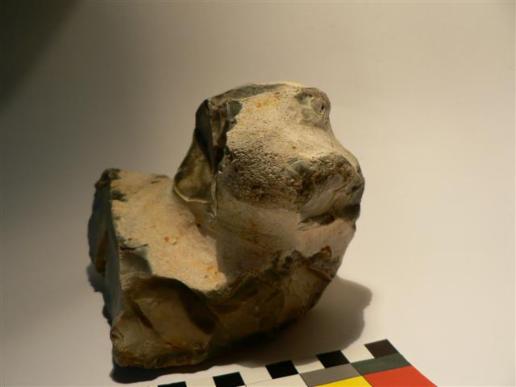
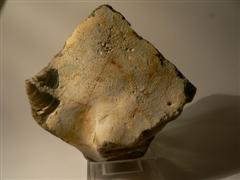
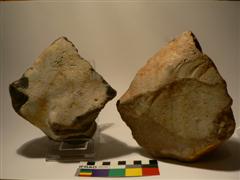
Entlehnte Elemente oder auch Wiederholungsthemen bis hin zur Kopierung, siehe Materialvergleich in Quarzit. /
Repeated themes through "borrowed" elements up to the point of copying- see the following quarzit sculpture.
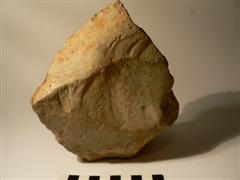
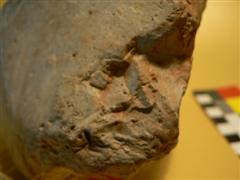
Foto rechts: Der Stein hat auch eine Gesichtsteil-Glype, und zeigt auf seiner Rückseite einen großen Nilpferdkopf, wie er auch auf dem nachstehenden Foto in Quarzit dargestellt worden ist. Ein Kopierungsbeleg.
photos.right: Small facial mask on this large stone.See also the back side view now, indicating a hippo-head form, repeated in quartzite material like shown on the following photos.
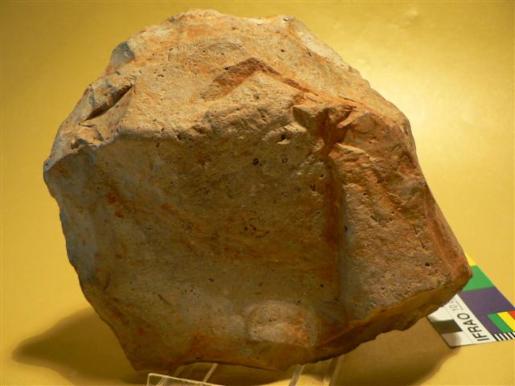
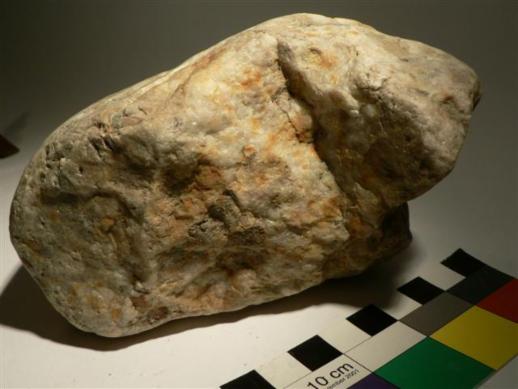
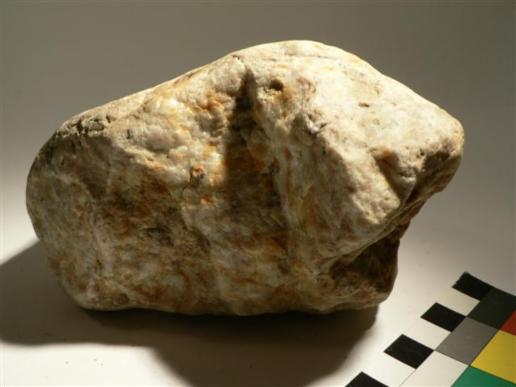
Flusspferd aus Quarzit in sitzender Pose, zeigt eine große Zahnandeutung, typisches aufgerissenes Maul und breite Kopfform. Dieser Typus hat Gegenstücke, aufgefunden im süddeutschen Raum,siehe dazu auch nachstehende Fotos, aus dem Sammlungsbestand von Herrn Kurt KOCHER.
This type of hippo, here in a sitting position, is fashioned in quartzit and has indication of large tooth, wide open mouth and large head. Such types also in quartzite material, were sampled in the southern part of Germany by KURT KOCHER; and are presented here for comparison on the next photos.
"BATTENBERGER FLUSSPFERD-DARSTELLUNGEN"
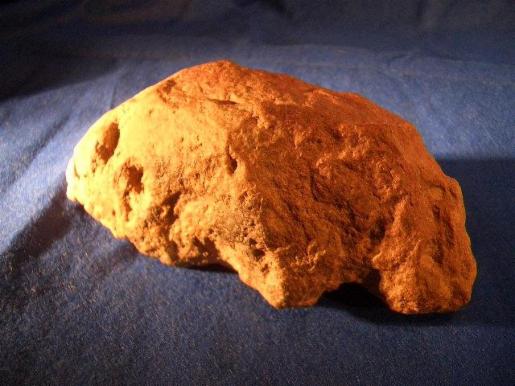
Nilpferd von der süddeutschen "Battenberg-Fundstelle", die eine mittel-bis altpaläolithische Datierung trägt, und damit älter als 350.000 Jahre sein kann.Aus der Sammlung von Herrn KURT KOCHER, kommend, hat dieses Fundstück die Form eines erkennbaren Tieres, welches in horizontaler Ansicht selbständig steht. Rundum werden Bearbeitungsspuren sichtbar mit einer dunklen Patinierung an einer Stelle, die den Eindruck erweckt, dem Feuer ausgesetzt gewesen zu sein. Herr Kocher übersendet dieses Stück mit einer "Sehhilfezeichnung" für einen direkten Vergleich zu den norddeutschen Fundstücken.
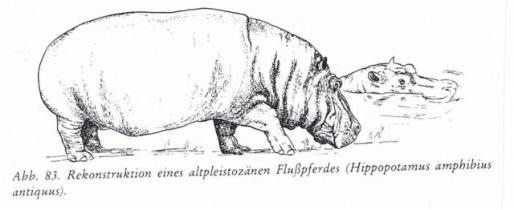
Aus URGESCHTE IN BADEN-WÜRTEMBERG . hrsg. von Hansjürgen Müller-Beck, unter Mitarbeit von Gerd Albrecht Zeichng und Rekonstruktion von Ingrid und Burkhard Pfeifroth-STUTTGART. Theiss Verlag 1983/ISBN 3-8062-0217-6
For comparison MR.KURT KOCHER, offered his find from the middel - and old palaeolithic find site of BATTENBERG,together with a reconstruction of an old-pleistocene Hippopotamus. His find is estimated older than 350.000 years, it shows, without doubt, the body of an animal, to be viewed in horizontal position, working traces are clearly shown, on one spot it has a patination resembling traces of fire.
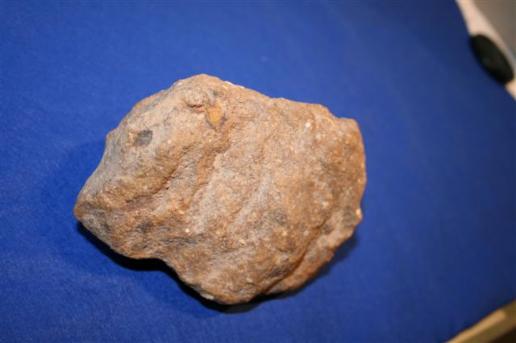
Ebenfalls aus dem Sammlungsbestand von K. KOCHER wird eine Teildarstellung eines Flusspferdes gezeigt, mit den Abmessungen: L 15cm, H 9,7cm und B 6,4cm. Hier ist der Schwerpunkt der Skulptur auf die Kopfdarstellung orientiert, gut erkennt man die kleinen Ohren und den angezeigten Oberkiefer sowie den breiten Unterkiefer des Tieres. Die leicht hervortretenden Augenwülste und die Nackenfalten sind Detailwiedergaben für eine korrekte Interpretation dieser Tierart. Die Fundstelle ist ebenfalls BATTENBERG, das Material scheint wenig gerollt und besteht aus Quarzit.Vgl.LINK-Kapitel für mehr Info. über Battenberg-Fundstelle, K. Kocher.
This sculpture represents the head and neck of a hippo, giving details about small ears, fat neckline, mouth shape, accentuating upper and lower yaw, and the typically eye sockets of this animal, affirming the correct interpretation.Measurements: L 15cm, h 9,7cm w. 6.4cm.Material: quartzite, find site: BATTENBERG. Details about this site: see my LINK page for Kurt Kocher
9.Jan. 2009 Erweiterung/ additional pictures June 2009 and July 27th 2009 / 25.10.2009 Hippo series completed.
FUSSFORMEN AUS GROSS-PAMPAU
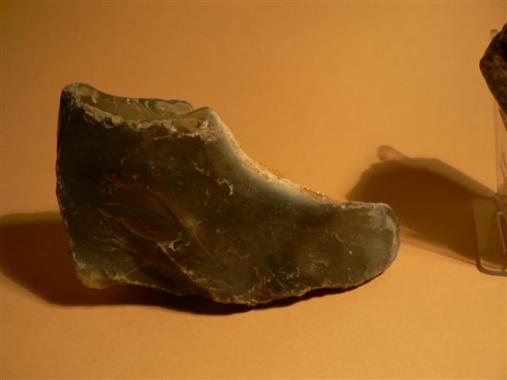
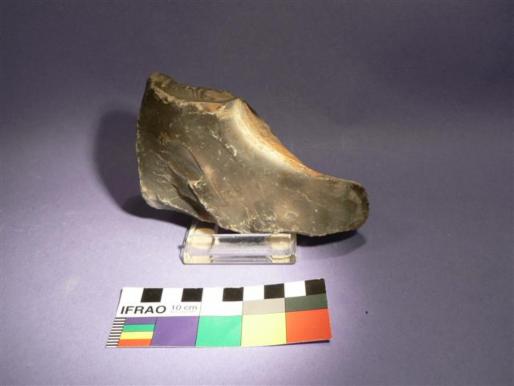
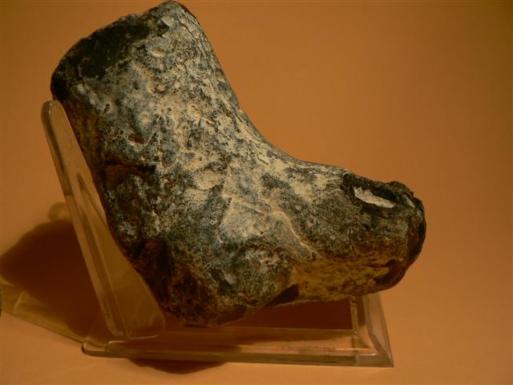
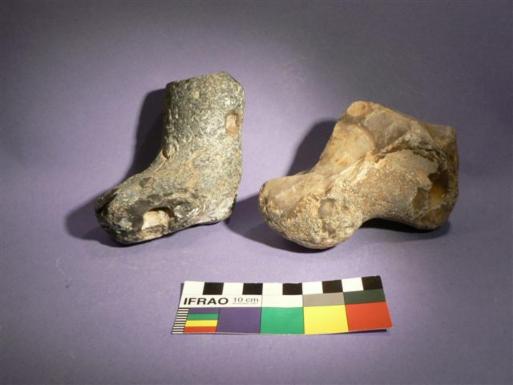
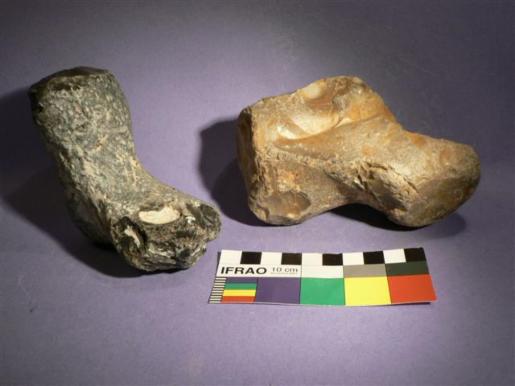
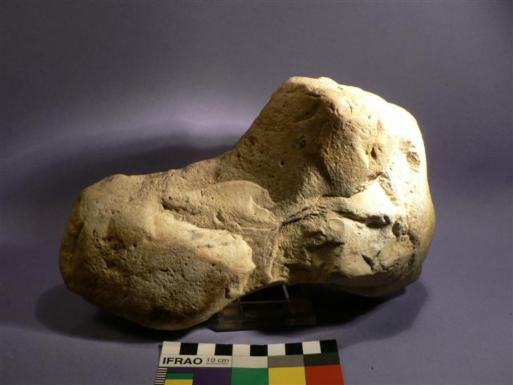
Von Kindergröße bis "big foot" size "Fussformen aus Feuerstein" von Gr.-Pampau